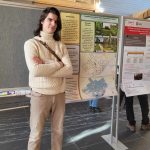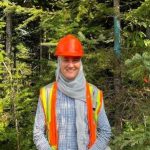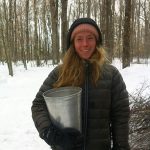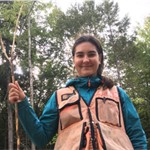 ALES Loïc
ALES Loïc
loic.ales.1@ulaval.ca
Supervision: Maude Flamand-Hubert (Université Laval) and Nathalie Lewis (Université du Québec à Rimouski)
Voluntary Forest Conservation: Perspectives and Experiences of Quebec Forest Owners
The Quebec government has committed to protecting 30% of its territory by 2030. To date, most protected areas have been established in the northern part of the province, despite the significant anthropogenic pressures on the southern forests, which are rich in biodiversity. The conservation of these predominantly privately-owned forests, therefore, heavily relies on the owners’ adherence to existing programs. Current legislation offers several so-called “voluntary conservation” tools designed to grant legal protection status to private woodlands. Although this phenomenon has gained some traction recently, it has garnered little academic attention. My research project aims to address this gap through an exploratory approach. The methodology, which is predominantly qualitative, adopts a socio-anthropological perspective of the phenomenon. The results will enrich sociological knowledge regarding forest owners and aid in improving existing conservation tools to support provincial ecosystem conservation goals.
 AMY Arthur
AMY Arthur
arthur.amy.1@ulaval.ca
Supervision : Robert Beauregard (Université Laval) and Yan Cimon (co-supervision- Université Laval)
Valuing cellulose filaments in innovative, sustainable, and renewable bioproducts
In 2014, Kruger discovered Filocell, an innovative nano-cellulose fiber created from wood fibers. This product is still in search of industrial applications despite its potentially very interesting physico-chemical properties in various fields. The project will focus on the development of a business model for Kruger’s Filocell product, based on scientific research carried out on the subject over the last ten years. The project will also be based on a literature review of recent years. The research will focus on analyzing, comparing and questioning the industrial processes of various industries identified with the aim of integrating Filocell. The aim is to add value to existing processes and/or create new high-performance products. The ultimate goal of the project is to present Kruger with one or more ways of using Filocell in industrial-scale products in the areas identified above.
 BEAULIEU Antony
BEAULIEU Antony
antony.beaulieu.2@ulaval.ca
Supervision : Christian Dagenais (Université Laval)
Characterization of Wood Charring Exposed to Design Fire Scenarios
The combustible nature of wood limits the exposure of structural elements in buildings. An important value for dimensioning wooden elements is the charring rate during a fire. This charring rate leads to both an increase in the amount of fuel and a decrease in the strength of the elements. The objective of this master’s project is to provide reference values for the charring rate of wood exposed to different phases of a fire. Several factors influence this rate, heat release rate, ventilation, and wood density will be the primary factors studied in this project. Laboratory tests will be conducted at a small scale using a cone calorimeter and at a large scale using a propane furnace. The values obtained aim to help designers of wooden buildings predict the charring depth of wood in order to calculate residual strength during fire.
BEAULIEU Catherine 
catherine.beaulieu.14@ulaval.ca
Supervision: Alexis Achim (Université Laval)
 BELLEAU Ariane
BELLEAU Ariane
ariane.belleau.1@ulaval.ca
Supervision: Evelyne Thiffault (Université Laval) and David Paré (co-supervision – Ressources naturelles Canada)
Quantification of biogenic carbon reservoirs in power transmission lines in Quebec’s forested areas.
Quebec could become a major player in reducing greenhouse gases thanks to its ability to export hydroelectricity to neighboring jurisdictions to contribute to their decarbonization. However, we currently do not know the total carbon footprint of power transmission lines in our territory. The goal of this research project is to measure the biogenic carbon stocks of the transmission line network across Quebec’s forests in order to describe their dynamics. The analysis of stocks will be carried out mainly under two gradients of variability: i) the local ecological gradient created by the line corridors themselves and ii) the bioclimatic gradient of the hydroelectric network. To do this, I will study carbon stocks directly beneath the power line corridors, in the surrounding forests disturbed by the lines, and in undisturbed forests for comparison purposes. At the same time, extrapolation of my data will enable refinement of the complete life cycle analysis of hydroelectricity.
 BONNETAIN Léo
BONNETAIN Léo
leo.bonnetain.1@ulaval.ca
Direction : Pierre Blanchet (Université Laval) et Véronic Landry (co-supervision – Université Laval)
Design of an Insulating Structural Product for Commercial and Multiplex Construction
The durability of wood used outdoors is one of the barriers to its use. However, there are several ways to extend the life of a wood product. Applying a coating preserves the properties and controls the aesthetics of a product. This project aims to develop a system for protecting the exterior cladding of SIPBEs Structural Insulating Panels in Stackable Blocks to meet commercial and mid-rise multiplex construction market requirements. To achieve it, the design project is divided into four stages. The first is to draw up specifications to identify needs and risks clearly. In the second stage, technical solutions will be researched and selected. Thirdly, prototypes will be produced. Finally, the fourth stage of the project will be to carry out tests to evaluate the product’s performance.
 BOUFFARD Anne-Marie
BOUFFARD Anne-Marie
anne-marie-bouffard.1@ulaval.ca
Supervision: Evelyne Thiffault (Université Laval)
Impact of afforestation on surface albedo
 BOUFFARD Thomas
BOUFFARD Thomas
thomas.bouffard.1@ulaval.ca
Supervision: Évelyne Thiffault (Université Laval) and Éric Bauce (co-supervision – Université Laval)
Carbon Dynamics and Greenhouse Gas Budget Associated with Forest Protection Measures Against Spruce Budworm-Induced Damage
The spruce budworm (SBW) can cause growth losses and increased mortality among host species and thus potentially disrupt forest carbon dynamics. To mitigate these impacts, biological treatments such as the aerial application of Bacillus thuringiensis kurstaki (Btk) are used to reduce SBW populations and, consequently, the defoliation pressure on trees. This protection helps limit growth reductions and mortality, and could thereby support the maintenance of carbon sequestration. However, Btk spraying activities result in fossil carbon emissions. An experimental setup was established in the Côte-Nord region, in 2007, comprising five scenarios reflecting different spraying frequencies. This project aims to compare, for each scenario: I) the current distribution of carbon among ecosystem reservoirs, II) the modeled evolution of carbon stocks and fluxes throughout an epidemic cycle, and III) the net greenhouse gas (GHG) balances at the end of a cycle. The expected outcomes will help optimize treatment intensity by minimizing both biogenic and fossil carbon emissions, while maximizing carbon sequestration in forest ecosystems.
 BOULANGER Rosemarie
BOULANGER Rosemarie
rosemarie.boulanger.1@ulaval.ca
Supervision: Évelyne Thiffault (Université Laval)
Carbon footprint of farm woodlands
This project is part of an initiative aimed at accelerating the adoption of climate change mitigation practices in Quebec’s agricultural sector. It seeks to quantify the current and potential carbon balance of on-farm woodlots, in terms of forest carbon sequestration and emissions, to assess their contribution to the overall carbon balance of Quebec’s agricultural enterprises. Farmers often own land that includes, in addition to cultivated fields, on-farm woodlots. They are interested in practices that could increase the capacity to sequester atmospheric carbon and reduce carbon emissions from their woodlots. To identify and quantify opportunities for implementing such practices, the project aims to better understand the ecological and forest characteristics of on-farm woodlots and the current management practices in place, to establish their present carbon balance and evaluate alternative management options. The project is carried out in partnership with the Centre pour le développement de l’agriculture du Québec (CDAQ) and funded by Mitacs Accelerate.
 BOUTHENET Benjamin
BOUTHENET Benjamin
benjamin.bouthenet.1@ulaval.ca
Supervision: Alexis Achim (Université Laval) and Filip Havreljuk (co-supervision – DRF)
Effet de Fomitiporia punctata sur la croissance et la qualité du bois du chêne rouge.
Le Fomitiporia punctata est un champignon saprophyte assez courant en Amérique du Nord. On le retrouve sur du bois mort où il est capable de se nourrir et de se reproduire. Plus récemment, ce dernier a été observé sur des arbres vivants causant des déformations au niveau du tronc ainsi que de la carie chancreuse. La plantation comparative de chêne rouge d’Eaton, situé près de Sherbrooke en Estrie, en est un parfait exemple puisqu’aujourd’hui, plus de 20 % des arbres sont affectés par ce champignon. L’objectif général du projet est de mieux comprendre les effets du champignon Fomitiporia punctata sur la croissance et la qualité du bois du chêne rouge. Cette année, la plantation a été inventoriée et tous les arbres ont été dûment mesurés permettant d’identifier et de caractériser les arbres infectés. Cinquante arbres échantillons ont été sélectionnés, abattus puis sciés afin d’évaluer l’étendue de la carie dans le bois. Une fois les analyses complétées, les résultats de l’étude devraient permettre une meilleure connaissance du champignon et de son effet sur le bois de chêne rouge qui pourrait ultimement améliorer l’identification du pathogène dans les inventaires forestiers et les pratiques sylvicoles.
[/vc_column_text]
 COULAUD Félix
COULAUD Félix
felix.coulaud.1@ulaval.ca
Supervision: Alexander Salenikovich (Université Laval)
Evaluation and determination of the mechanical strength properties of sandwich beams
Composite sandwich beams, consisting of an insulating core of expanded polystyrene and laminated faces of ungraded white pine boards, are an attractive alternative for wall infill. This type of product provides a wood finish on both sides of a wall, while offering high-performance thermal insulation and structural stability. However, the specific type of composite beam described has never been directly studied. The main objective of this research is to determine the mechanical properties essential for design calculations to guarantee the quality and structural safety of structures built with this construction product. These strength values will also be used to create a constitutive and/or finite element model of the sandwich beam under study.
 COURTÈS Daphné
COURTÈS Daphné
DRCOU4@ulaval.ca
Supervision : Alexis Achim (Université Laval) et Guillaume Moreau (co-supervision – Université Laval)
Empirical Evaluation of the Effects of a New Tree Selection Approach During Selection Cutting on the Presence of Wildlife Microhabitats and the Maple Syrup Production Potential of Forest Stands
The health of deciduous forests in the temperate climate zone of southeastern Canada is currently precarious. These forests have experienced a decline in growth, particularly following a dieback episode in maple stands that began in the 1980s. Since then, the growth of maple stands has continued to decrease, and the forests are considered “degraded.” Additionally, current harvesting practices in these degraded stands face significant profitability challenges, as the harvested trees are often weak and of very low quality. A new classification system for standing trees was recently proposed to address the challenge of assessing tree vigor. This system simplifies tree marking while providing a more accurate assessment of tree vigor and incorporates an additional evaluation of tree quality to guide harvesting decisions. Simulation exercises have shown that tree selection using this system could increase both the quality of harvested wood and the vigor of residual stands. However, this tree selection system has never been applied in an industrial context. Moreover, its impacts on other ecosystem services, such as the availability of microhabitats for numerous dependent species and the maple syrup production potential of treated stands, remain largely unknown.
 CÔTÉ Rosalie
CÔTÉ Rosalie
rosalie.cote.5@ulaval.ca
Direction : Évelyne Thiffault (Université Laval), Ben Amor (codirection – Université de Sherbrooke)
Impact of forestry practices on the carbon footprint of construction timber products
Forest management influences the carbon balance of forest ecosystems and, consequently, the biogenic carbon footprint of harvested timber. However, life cycle assessments of construction wood do not systematically take biogenic CO2 flows into account. This study aims to quantify the impact of forest management parameters on the biogenic carbon balance of one cubic meter of wood from the eastern boreal forest. Using spatial organization compartments of Quebec’s boreal fir forest as case studies, we will develop scenarios incorporating four variables: harvest type (clearcut vs. selective cutting), harvest intensity, rotation age, and the proportion of wood destined for sawmilling or other uses. This quantification will help us improve our practices to achieve carbon neutrality and better integrate biogenic carbon into life cycle assessments.
 GAGNON Christopher
GAGNON Christopher
christopher.gagnon.3@ulaval.ca
Direction : Alexander Salenikovich (Université Laval) et Thomas Tannert (co-supervision – UNBC )
Strengthening dowel-type joints for solid wood structures using self-tapping screws
This research project focuses on improving the strength and ductility of solid wood joints, particularly those using dowel-type fasteners. The main innovation lies in the use of self-tapping screws (STS), which not only simplify installation but also reinforce wood joints by optimizing their mechanical performance. The goal is to prevent brittle wood failure by consolidating joints with STS. Various loading scenarios will be explored to better understand the impact of reinforcement on the performance of the joints. The results obtained will be used to develop analytical models for designing higher-performance joints and to formulate guidelines for inclusion in the CSA O86 standard for calculating wood structures. This project aims to produce empirical data and improve design practices, thereby promoting wider and more sustainable adoption of solid wood in contemporary construction.

GIASSON Louis-David
louis-david.giasson.1@ulaval.ca
Supervision: Alain Cloutier (Université Laval) and Isabelle Duchesne (Canadian Wood Fibre Centre)
Use of trees killed by insect outbreaks or wildfires for the production of particleboard p sanels.
Currently, very little scientific literature is available to justify the use of wood from natural disturbances in the panel industry. This project aims to evaluate the feasibility of including such wood in the production of particleboards and to assess their performance. For this purpose, particleboards will be manufactured using trees harvested after wildfires and trees affected by the spruce budworm. The physical and mechanical properties of these panels will then be evaluated to determine whether this biomass can be effectively used for particleboard production.
 HADHRI Salsabil
HADHRI Salsabil
salsabil.hadhri.1@ulaval.ca
Supervision: Véronic Landry (Université Laval)
Development of antibacterial coating for melamine laminated particleboard surface.
Melamine-laminated particleboards exhibit excellent performance, such as resistance to impact and chemicals. In environments like hospitals and kitchens, surfaces must meet high hygiene standards. While melamine-coated surfaces are relatively easy to clean, their antimicrobial properties need enhancement. This project aims to develop an antibacterial finish with low volatile organic compound (VOC) content for melamine-laminated panels, ensuring it is effective, long-lasting, and safe for humans and the environment. The finish will incorporate a polymer system with antibacterial properties. Ideally, antimicrobial additives will be immobilized within a resin matrix to prevent their gradual removal during cleaning. This might involve using metallic compounds (e.g., ions, oxides). Another approach is to chemically modify the surface with bactericidal functionalities, such as quaternary ammonium compounds or phosphonium salts, which can kill bacteria upon contact. The best strategy will be evaluated, and antibacterial coatings will be applied to the panel surfaces. The physical (e.g., hardness, adhesion, abrasion resistance), chemical (e.g., chemical resistance), and antibacterial properties will be assessed.
JEMNI Rania
rania.jemni.1@ulaval.ca
Supervision: Évelyne Thiffault (Université Laval)
Characterization of post-consumer panels as a source of biomass for bioenergy production
The research project aims to characterize the variability of the physical and chemical properties of post-consumer panels, with a focus on the presence of formaldehyde and other contaminants. These analyses will provide a better understanding of the factors influencing these properties and assess their potential as raw material for thermochemical conversion into bioenergy (bio-oil, biochar, syngas). The objective is also to identify the conditioning and pretreatment requirements for these panels in order to optimize their efficiency in renewable energy production. The expected benefits include the reduction of wood waste and the optimization of energy conversion processes, thereby contributing to sustainable development and the recovery of post-consumer materials.
KHADHER Khadija
khadija.khadher.1@ulaval.ca
Supervision: Daniel Beaudoin (Université Laval) and Rémi Georges (Université Laval)
Improving wood quality delivered to sawmill : Case study
Poor quality logs delivered to sawmills could have a significant impact on mill performance and workers’ health and safety. The research project aims to improve the quality of sawlogs delivered to sawmills by identifying the causes of sawing line downtime and prioritizing them according to their criticality, as well as identifying their origins in forest operations and formulating recommendations.
 LE MARÉCHAL Marius
LE MARÉCHAL Marius
marius.le-marechal.1@ulaval.ca
Supervision: Évelyne Thiffault (Université Laval)
Carbon storage in urban areas: biophysical and socioeconomic considerations.
In the context of climate change, cities are becoming increasingly aware of the importance of protecting their green spaces for their ability to retain atmospheric carbon. However, municipal institutions often tend to separate environmental issues from socioeconomic realities in the areas where they implement their policies. In this project, using Quebec City as a case study, we assessed the spatial relationships between the city’s current biogenic carbon stocks and the social and economic characteristics of its population. We quantified carbon concentrations in the various ecosystems within the city, classified according to the areas in which they were located (based on their socioeconomic index). We then quantified the spatial relationship using Moran’s I. The analysis shows that poorer areas have less green space than wealthier areas. The key takeaway from this project is that public planning decisions must take into account the socioeconomic situation of the populations that will be affected by them. A better understanding of the territory makes it possible to protect it and ensure a viable environment for its population.
 LE SOUDER Pierre-Mathis
LE SOUDER Pierre-Mathis
pierre-mathis.le-souder.1@ulaval.ca
Supervision: Pierre Blanchet (Université Laval) and Franck Michaud (co-supervision – École Supérieure du Bois, Nantes, France)
Assessment of end-of-life scenarios for a wooden building.
The construction industry is under pressure to improve its environmental footprint, and wood construction is no exception. At the same time, industrialized societies are organizing to increase the implementation of strategies favouring end-of-life scenarios of goods that will keep materials in circulation. This circularity must also apply to the building sector, a sector that stores materials for a significant period of time (50 to 100 years) and that must offer a mitigation strategy for end-of-life impacts. The ability to reuse materials is highly dependent on the ability to disassemble buildings without damaging components, especially structural components. The objective of this project is to evaluate and qualify end-of-life scenarios for a fictitious glued-laminated beam-post building. The study will focus on the environmental impact of the connectors and their importance in the final assessment of the building. The main tool is going to be life cycle assessment.

LEGENDRE Thomas
thomas.legendre.1@ulaval.ca
Supervision: Alain Cloutier (Université Laval) and Ahmed Koubaa (co-supervision – UQAT)
Optimizing the performance of orienteers to maximize the mechanical properties of
OSB panels.
Given that wood is an anisotropic material, its fiber orientation plays a major role in its mechanical strength. To optimize the performance of OSB panels, it is necessary to control the orientation of the strands. This project aims to maximize the mechanical properties of OSB panels by optimizing the performance of the orienters.
During the mat formation process, wood strands pass through orienters to align the layers of the panel perpendicular to each other. By improving the longitudinal orientation of the surface flakes, it would be possible to reduce the panel’s density while maintaining its bending strength. Material yield for panel manufacturing would increase, reducing production costs.
The influence of the height of the orienters, the rotation speed of the discs/paddles, and the drop point in the orienter will be the variables studied in this research.
 LEGRAIS Oscar
LEGRAIS Oscar
oscar.legrais.1@ulaval.ca
Supervision: Pierre Blanchet (Université Laval) and Clément Boudaud (co-supervision – École Supérieure du Bois, Nantes, France)
Qualification of an under-used hardwood species for the manufacture of engineered products.
To properly manage the evolution of the wood construction sector, other wood species must be considered. A study on the use of quaking aspen (Populus tremuloides Michx) would be a solution to decrease the utilization of softwoods. Despite its hardwood properties, this species could find a niche in certain specific applications, such as glulam or CLT. It also has the advantage of offering a unique and uniform aesthetic and is known to accept dyes and finishing products.
The objective of the project will be to evaluate this species for the manufacture of glulam. The project will require intensive sampling to establish the distribution of mechanical properties. Bonding, shear strength and delamination tests will also be performed. Finally, depending on the observations obtained during the project, full size beams can be fabricated and tested in bending tests.
 MAZURYK Léna
MAZURYK Léna
lena.mazuryk.1@ulaval.ca
Supervision: Alexis Achim(Université Laval) and Benjamin Kissinger(co-supervision – – FRI Research)
Assessing the impacts of forest management and natural disturbances on the habitat of native trout in Alberta
Native trout populations in Alberta’s Eastern Slopes are facing increasing pressure from human activities that alter their habitats and threaten their long-term survival. This master’s project aims to study how various natural (wildfires) and anthropogenic (logging and OHV roads) activities impact native trout habitats in this region. While past research has often focused on fish populations and water quality, this study will use macroinvertebrates as bio-indicators of native trout habitat health. These organisms are highly sensitive to environmental changes and exhibit strong site fidelity, making them effective for assessing ecosystem conditions in delineated areas. Stable isotope analysis will help track changes in food sources and food web relationships by distinguishing between terrestrial and aquatic inputs. High-resolution LiDAR will map riparian zones, stream morphology, and the extent of these disturbances, while field data on temperature,
turbidity, sedimentation, and dissolved oxygen will be collected to evaluate their influence on habitat quality. By combining these methods, this project aims to explore an alternative approach to habitat assessment for native trout. This research seeks to understand how disturbances shape habitat conditions and food web interactions, leading to new directions for the protection of healthy trout ecosystems in Alberta’s Eastern Slopes.
 MORISOT Guilhem
MORISOT Guilhem
guilhem.morisot.1@ulaval.ca
Supervision: Xiaodong (Alice) Wang (Université Laval)
Design and testing of a prefabricated wooden house using Phase Change Materials for insultation in different climates.
The research project will concern the insulation of prefabricated wooden frame houses with PCM (Phase Change Materials). We will pose the problem of how these materials allow us to reduce the carbon footprint of a building while ensuring optimal comfort in winter and summer. The objective of the research will be to provide ecological solutions as well as optimization of theses houses which will make it possible to reduce energy consumption across different climates thanks to PCM materials. For this, we will carry out tests on a wooden frame wall in the laboratory by modifying and comparing some biosourcedd thermal insulations such as hemp wool, wood etc… Subsequently we will add the comparing PCM as well as the benefits that this brings for the interior comfort in winter and summer. The expected benefits are rather positive PCM will make it possible to add greater energy density and therefore store a lot of energy, thus reducing the overheating of houses in summer but still allowing heat transmission in winter.
 MZOUGHI Maher
MZOUGHI Maher
maher.mzoughi.1@ulaval.ca
Supervision: Véronic Landry (Université Laval)
Development of a flame-retardant coating based on polyelectrolyte complexes for wood
Wood is a natural material that is appreciated in a variety of fields, including construction, because of its mechanical properties and abundance. However, its flammability leads to safety risks and limits its use. For this reason, fireproofing wood is a priority for manufacturers to improve its fire performance. On the other hand, existing fireproofing systems have limited effectiveness, can alter the visual appearance of the wood, and release halogenated gases that are harmful to health. This project aims to develop a fire-retardant coating for wood based on polyelectrolyte complexes, focusing on bio-based polyelectrolytes and by-products from the forestry industry. Then fillers such as clay nanoparticles can be added. Once applied to the wood, the coatings will be tested to assess their fire behaviour using a calorimeter cone.
 OFFROY Coralie
OFFROY Coralie
coralie.offroy.1@ulaval.ca
Supervision: Alexander Salenikovich (Université Laval) and Christian Dagenais (co-supervision – Université Laval)
Fire Resistance Assessment of Metal Connections in Mass Timber Structures
The growing use of mass timber in construction is driven by its environmental, aesthetic, and structural advantages. However, the integration of connections including metal plates and fasteners, raises important fire safety concerns. Unlike timber, which chars slowly while maintaining some load-bearing capacity, metal components lose their strength rapidly when exposed to high temperature. This research project aims to better understand the fire performance of such connections. Experimental testing combined with numerical modeling will be used to analyze their thermal and mechanical behavior and to assess the influence of design parameters such as connection geometry and plate or fastener type. The goal is to develop practical recommendations to ensure the fire safety of mass timber structures. The expected results will help fill a current knowledge gap and support the evolution of design practices and building code provisions related to fire resistance in metal connections.
 RATEFIARISON Finidi-Désiré
RATEFIARISON Finidi-Désiré
finidi-desire.ratefiarison.1@ulaval.ca
Supervision: Nancy Gélinas (Université Laval) and Miguel Montoro Girona (co-supervision– Université du Québec en Abitibi-Témiscamingue)
Analysis of the economic and financial profitability of partial cutting – the case of experimental regular shelterwood cutting in the Côte-Nord region of Québec
Forestry is a crucial sector for the Quebec economy, and to preserve these resources over the long term, sustainable forest management is essential. However, the widely-used total-cutting method has ecological drawbacks. To address these issues, ecosystem-based forest management advocates the use of partial cuts to integrate ecological, economic and social objectives. Partial cutting is a solution forsilvicultural diversification in the boreal forest, but its economic viability remains insufficiently studied. Our objective is therefore to analyze the economic and financial profitability of innovative partial cutting treatments, and to identify factors influencing their profitability in order to define windows of opportunity . The results of our study will guide future sustainable forest management decisions in Quebec by providing information on the most profitable types of regular shelterwood cutting, the potential economic benefits, and the parameters to be considered for wider implementation of partial cutting.
 SIMON Flore
SIMON Floreflore.simon.1@ulaval.ca
Supervision: Alain Cloutier (Université Laval) and Franck Michaud (École Supérieure du Bois, France)
Development of mold-resistant OSB panels.
In North America, oriented strand boards (OSB) are primarily used in residential construction and renovation. OSB are structural panels with high mechanical performance but are susceptible to moisture and mold without appropriate treatments. The presence of mould not only reduces the aesthetic quality of the product, but can also lead to health problems such as respiratory illnesses in the occupants of a contaminated building. These organisms could also weaken the material’s structure, reduce mechanical strength, and cause deformation or panel rupture. Developing panels that are more resistant to mold is an advantage for the Canadian industry, enabling them to offer more high-performance and durable products and enhance competitiveness in the market. This project aims to assess and optimize using one or more fungicidal treatments capable of increasing OSB’s resistance to mold while preserving the panel’s original physical and mechanical properties. The project will prioritize using fungicidal products free from volatile organic compounds, toxic substances, and solvents, allowing for recycling strands or panels treated at the end of their lifecycle.
 YARGEAU Marilou
YARGEAU Marilou marilou.yargeau.1@ulaval.ca
Supervision: Evelyne Thiffault (Université Laval) and Miguel Montoro-Girona (co-supervision – Université du Québec en Abitibi-Témiscamingue)
Partial cutting in boreal forests as a tool for maintaining and restoring old-growth forest attributes.
In Quebec, part of the eastern boreal forest has a more humid climate, making fire return infrequent. The stands there are subject to a regime of disturbances through gaps, which creates uneven-aged forests with irregular structures. Most of the harvesting carried out there is clear-cutting with protection of regeneration and soils. This silviculture is poorly suited to the natural disturbance regime, and old-growth forests are becoming increasingly rare. The objective of the study is to determine whether partial cuts with harvest rates between 25% and 40% are best suited to restoring and maintaining the structure and composition attributes of natural stands. The study is being conducted in the Montmorency Forest, which is representative of white birch fir forests in the eastern boreal forest. With this approach, we hope to modify management practices to better represent the natural disturbance regime in order to meet ecosystem management criteria. We also hope to contribute to the fight against climate change by increasing the resilience of our forests.
 ABID Liza
ABID Liza
liza.abid.1@ulaval.ca
Supervision: Véronic Landry (Université Laval) and Tatjana Stevanovic (co-supervision – Université Laval)
Development of interior coatings for lignin/acrylate/malonate wood.
Wood is known for its abundance, mechanical performance, and insulating properties. As a result, overcoming the limitations of wood, such as its hygroscopicity and resistance to chemical, biological, and mechanical degradation, has become a challenge. There are several ways to protect and improve the durability of this material, including chemical impregnation and the application of coatings to the surface of the wood. In addition, the scarcity of the raw material (fossil) used in the design of existing coatings has prompted researchers to seek to replace it with other, more environmentally friendly materials. The aim of this study is to develop a photo-polymerizable coating based on valorized lignin extracted from sugar maple (Acer saccharum) and red oak (Quercus rubra) bark, using a green chemistry reaction (Michael addition) that limits VOC emissions and allows deep polymerization. This coating is intended to protect interior wood, mainly from mechanical damage that reduces its performance and longevity. This project consists of three main parts. The first will be the extraction of lignin using the Organosolv process, where the solvent will be ethanol-water in the presence of a catalyst (FeCl3). The second part will focus on modifying the previously extracted lignin by performing direct or indirect grafting (in the presence of epoxy) with acrylic acid or acryloyl chloride in order to integrate the lignin into the coating. The third part consists of combining the activated lignin with malonate monomers (commercially available dimethyl malonate and a tetramalonate that will be synthesized) for the preparation of highly cross-linked polymer systems by Michael addition.
 ABOU-HAIDAR Sandra
ABOU-HAIDAR Sandra
sandra.abou-haidar.1@ulaval.ca
Supervision: Charafeddine Jama (Centrale Lille Institut) and Véronic Landry (co-supervision – Université Laval)
 ALINEZHADAVALZALI Hossein
ALINEZHADAVALZALI Hossein
hossein.alinezhadavalzali.1@ulaval.ca
Supervision : Véronic Landry (Université Laval), Diego Mantovani (Co-supervision-University Laval) et Papa Diouf (Collaboration-SEREX)
Development of antibacterial coating for melamine laminated particleboard surface
Melamine laminated particle boards are widely used in high-traffic environments such as hospitals, medical offices, schools, and restaurants due to their excellent hygiene, impact resistance, chemical durability, and ease of maintenance. To ensure surface hygiene and limit the growth of viruses and bacteria, the development and application of an effective antibacterial coating is essential. This project aims to develop an antibacterial coating with low volatile organic compounds (VOCs) concentration that is effective, durable, and safe for humans and the environment. This research represents an important step toward enhancing hygienic, sustainable, and environmentally friendly surface coatings for wood composite materials, contributing to improved health and safety in public and medical environments.
 ARMEL ZAMBOU Kenfack
ARMEL ZAMBOU Kenfack
kenfack.armel-zambou.1@ulaval.ca
Supervision : Rémi Georges (Université Laval), Michael Morin (Co-supervision-Université Laval)
Reduction of Energy Consumption Associated with Fiber Refining in MDF Production
MDF (medium-density fiberboard) is a non-structural engineered wood panel made from wood fibers (82%), binder, water, and wax, formed under heat and pressure. It is widely used in furniture, kitchen fittings, and interior decoration. Fiber refining is critical for product quality and energy consumption. Disk refiner parameters (geometry, spacing, retention time), the nature of the raw material (wood type), and pre-steaming conditions (pressure, temperature) directly affect the fibers, and consequently the panel’s properties and cost. Currently, settings rely primarily on human expertise, which can cause errors and lacks real-time analysis. Process modeling using artificial intelligence and industrial refiner experiments enables prediction and optimization of energy consumption and fiber quality. Benefits include industrial cost savings, improved panel quality, enhanced competitiveness, and reduced environmental impact.
 AVERU Alima Carlors
AVERU Alima Carlors
alima-carlos.averu.1@ulaval.ca
Supervision: Pierre Blanchet (Université Laval)
Characterization and modeling of simple prefabricated house made of sandwich-like iPanels in Mozambique climates.
Prefab house is a kind of eco-friendly and economical house with sandwich type iPanels as skeleton and enclosure. This type of mobile home is composed of two-layer formed panels and an internal thermal insulation core directly foamed and cured in the middle of the panels. At present, prefabricated houses are mainly used in construction site dormitories, public toilets and customs boxes in some countries. While in Mozambique it could help solve the housing problem in overcrowded areas of the capital or other poor rural areas. This type of house can be assembled and disassembled easily and quickly, realizing the general standardization of temporary buildings, establishing the concept of environmental protection, energy saving, rapid and efficient construction, and bringing temporary houses into the market.
The project aims to consider a new conceptual design and integration of the PCM material-envelope system with the simple prefabricated house, in order to help and improve the quality of life of Mozambicans.
 BEAULNE Joannie
BEAULNE Joannie
joannie.beaulne-raymond.1@ulaval.ca
Supervision: Evelyne Thiffault (Université Laval) and Michelle Garneau (co-supervision – Université du Québec à Montréal)
Dynamics of carbon storage in forested wetlands in southern Quebec.
Wetlands are among the most important terrestrial carbon reservoirs and play a key role in nature-based climate change mitigation. Forested wetlands, i.e. forested peatlands and treed swamps, are widespread in Québec but remain poorly documented. The main objective of this project is to evaluate the dynamics of carbon storage in forested wetlands in southern Quebec, and to determine how this is impacted by forest management and anthropogenic disturbances, and by climate change. More specifically, carbon masses and accumulation rates in soil and vegetation will be quantified in “natural” sites, sites managed for forestry, and disturbed sites. Moreover, tree growth will be measured, along with tree sensitivity to changes in local climatic and environmental conditions. For comparison, upland forests will also be studied under this project. Defining the role of forested wetlands in climate change mitigation will allow a better ecosystem management and will support wetland conservation policies.
 BERNUDEZ-ESCOVAR Julio
BERNUDEZ-ESCOVAR Julio
julio.bernudez-escovar.1@ulaval.ca
Supervision: Roger Hernández (Université Laval) and Alexis Achim (co-supervision – Université Laval)
Non-destructive evaluation of wood from Calophyllum brasiliense cambess trees from the Bajo Calima region, Buenaventura, Colombia.
This research project compares the wood quality of Calophyllum brasiliense Cambess (aceite maría) trees from plantations and natural habitats in the Bajo Calima region of Colombia using non-destructive methods. The results will be used to compare the wood quality of trees growing in natural environments with that of plantation trees. These results will also help to select the most appropriate applications to increase the added value of young and mature trees of this species. This will improve the rational use of wood and help prevent the depletion of Colombia’s tropical forests as part of the implementation of the national forest development plan.
 BIRJEES Maimoona
BIRJEES Maimoona
maimoona.birjees.1@ulaval.ca
Direction : Evelyne Thiffault (Université Laval) et Nelson Thiffault (co-supervision– RNCan)
Understanding White Spruce Decline in Eastern Boreal Forests: Factors Influencing Chlorosis and Implications for Sustainable Forest Management
White spruce (Picea glauca (Moench) Voss) is a crucial species in Quebec’s reforestation efforts due to its adaptability, high productivity, pest resistance, longevity, and superior wood quality. However, increasing concerns have emerged regarding the health of white spruce populations, particularly in reforested stands, where some trees are exhibiting symptoms of chlorosis, i.e., yellowing needles that often indicate stress or poor health. This phenomenon could be linked to multiple factors, including nutrient deficiencies. Climate change could also be a significant factor, with rising temperatures, more frequent extreme weather events, and shifting precipitation patterns. This research project aims to explore the underlying causes of white spruce decline in the Eastern White Spruce-Balsam Fir forests, specifically in the Réserve faunique des Laurentides. By investigating the complex interplay of edaphic, climatic, and silvicultural factors, the project will assess how these factors contribute to chlorosis and inform strategies to mitigate further damage. The study will involve extensive field surveys, soil and foliage nutrition analysis, and climate modeling to better understand the situation.
 BOLDUC Gabriel
BOLDUC Gabriel
gabriel.bolduc.2@ulaval.ca
Supervision: Alexandre Morin-Bernard (Université Laval) et Yan Boucher (co-supervision – Université du Québec à Chicoutimi)
Monitoring growth trajectories and structural dynamics of temperate forests managed through partial harvesting using remote sensing.
Temperate forests of northeastern North America are predominantly managed through partial harvesting, an approach designed to maintain a permanent forest cover while promoting the return of old-growth attributes that are essential to biodiversity. Despite several decades of implementation, limited knowledge exists on the growth dynamics and large-scale condition of these forests, making it difficult to fully assess the effectiveness of current practices. This project aims to bridge this gap by integrating ground-based forest inventory data, satellite imagery, and provincial airborne LiDAR surveys to document post-harvest changes in forest growth, structure, and composition. This approach will help determine whether partial harvesting supports the maintenance of structural complexity and the recovery of old-growth characteristics. The results will strengthen the foundations of sustainable forest management and help guide the evolution of silvicultural practices in deciduous-dominated forests.
 BOUCHARD David
BOUCHARD David
david.bouchard.17@ulaval.ca
Supervision: Luca Sorelli (Université Laval) et David Conciatori (co-supervision – Université Laval)
Recycling industrial waste from the natural stone industry to produce high-performance and ultra-high-performance eco-friendly concrete.
The quarrying and processing of dimensional stone (granite, limestone, marble) generates a significant volume of waste that is difficult for companies to manage and incurs both short- and long-term costs. This waste comes in two main forms: coarse cuttings and sawdust. The objective of this research project is to recycle this waste (mainly sawdust) in high value-added applications, particularly in various types of concrete. The concrete produced as part of this project is categorized as high- or ultra-high-performance concrete. These different types of concrete were optimized using state-of-the-art numerical models to maximize the compactness of the components within the mixtures. Environmental and economic impacts were also taken into account in the formulation of the concrete. Various concrete mixtures with very low environmental impact were developed as part of this project.
 BOUDREAULT Laurence
BOUDREAULT Laurence
laurence.boudreault.3@ulaval.ca
Supervision: Alexis Achim (Université Laval) and Maude Flamand-Hubert (co-supervision – Université Laval)
Selection and characterization of black ash used for traditional W8banaki basketry.
Black ash, an essential species for traditional W8banaki basketry, is currently threatened by the spread of the emerald ash borer. The wood of this species is highly flexible and mechanically strong, making it the ideal material for this activity, which is closely linked to W8banaki identity. This collaborative project adopts a mixed methodology combining an anthropological approach with wood science. We believe that by gaining a better understanding of the physical and mechanical properties of black ash wood, it will be possible to develop tools to facilitate the adaptation of social and cultural practices associated with basket weaving in the context of the spread of the emerald ash borer. The project is therefore part of a proactive approach that aims to adapt to global changes rather than suffer their consequences.
 BRETON Charles
BRETON Charles
charles.breton@gci.ulaval.ca
Supervision: Pierre Blanchet (Université Laval), Ben Amor (co-supervision – Université de Sherbrooke) and Francesco Pomponi (co-supervision – University of York)
Characterizing sustainable building practices for Quebec’s national housing stock
LCAs are often available for products, systems, and buildings. However, how can these results be scaled to provincial or national scopes? The main goal of this project is to identify sustainable pathways to reduce the environmental impacts of the building stock in a life cycle approach, with a focus on mitigating climate change. Through a dynamic material flow analysis approach, and using environmental data (environmental product declarations, LCA) and historical statistics, the project will lead to a prospective model of Quebec’s housing stock to analyse and compare the environmental of different constructive strategies.
 CARDONA Lady
CARDONA Lady
lady.cardona.1@ulaval.ca
Supervision: Alexis Achim (Université Laval)
Variations géographiques des caractéristiques du bois de l’épinette noire dans la forêt boréale de l’est du Canada.
Étant donné l’importance écologique et socioéconomique de l’épinette noire, ainsi que des variations des propriétés du bois à différentes échelles (de l’arbre, locale et du paysage) et les interactions possibles avec les traitements sylvicoles, il est important d’utiliser une base écologique pour mieux comprendre les corrélations existantes entre le climat, perturbations naturelles et propriétés du bois. Pour atteindre cet objectif, il est nécessaire de départager les effets de multiples sources de variation potentielles. Dans ce projet nous allons donc utiliser un gradient latitudinal, deux extrêmes est-ouest dans un gradient longitudinal et une chronoséquence après feu et après coupe. Cette approche nous permettra d’isoler les effets potentiels du climat et des perturbations du couvert forestier sur les variations géographiques des caractéristiques du bois de l’épinette noire dans la forêt boréale de l’est du Canada.
 CARRIER Alexandre
CARRIER Alexandre
alexandre.carrier.8@ulaval.ca
Supervision: André Potvin (Université Laval) and Pierre Blanchet (co-supervision – Université Laval)
Housing crisis and climate challenges: an integrated tool for reducing the carbon footprint in the initial phases of architectural design.
The housing crisis in Quebec and Canada requires the construction of millions of new homes by 2030, but current construction techniques are likely to significantly increase greenhouse gas (GHG) emissions. The building sector is responsible for nearly 30% of Canada’s emissions, including the production of materials and building operations. To achieve carbon neutrality by 2050, architects need to minimize the carbon footprint of buildings from the early design stages. Existing life cycle assessment (LCA) tools are often too complex, require data that is unavailable at the start of a project, or are designed for experts, which hinders their use by building professionals. This research aims to develop an integrated tool into the early stages of design, enabling building professionals to rapidly assess the carbon footprint of their projects. This tool will provide evidence-based data to make informed decisions, transforming design practices to create housing that meets environmental targets. The results will have a tangible impact on how housing is designed and will support global efforts to reduce GHG emissions.
 CHAMDJOU-TCHAMDJOU Junie-Brodel
CHAMDJOU-TCHAMDJOU Junie-Brodel
junie-brodel.chamdjou-tchamdjou.1@ulaval.ca
Supervision: Jean-François Bissonnette (Université Laval) and Nancy Gélinas (co-supervision – Université Laval)
Contribution of agroforestry to reducing the vulnerability of populations in the Cameroonian highlands to climate change.
Agroforestry is documented in research and programs as an approach that can contribute to farmers’ adaptation and mitigation in the face of climate change. However, their resilience seems to be less and less effective in view of the socioeconomic, food, and environmental constraints they face. That being said, can agroforestry systems reduce farmers’ vulnerability to climate change? The objective of this thesis is to evaluate the contribution of agroforestry systems to reducing the vulnerability of populations in western Cameroon. The strategies defined by the REDD+ program’s technical secretariat can promote agroforestry practices, and the identified adoption factors, such as income diversification, soil fertilization, and the creation of a microclimate, encourage farmers to practice agroforestry techniques. Agroforestry practices could be a springboard for farmers to become resilient to climate change.
 CHEN Yuchen
CHEN Yuchen
yuchen.chen.1@ulaval.ca
Supervision: Pierre Blanchet (Université Laval)
Characterization and modeling of building envelope performance: Relationship between location in building and insulation type.
We try to study the various hygrothermal exchanges occurring inside a wooden building envelope with bio-based insulation materials in the Quebec context, including numerical modelling and experimental for the thermal and hygroscopic properties of the full-scale building envelope.
 CORDIER Sylvain
CORDIER Sylvain
Sylvain.Cordier@USherbrooke.ca
Supervision: Ben Amor (Université de Sherbrooke), Pierre Blanchet (co-supervision – Université Laval) and François Robichaud (co-supervision – Getfea)
Consequential LCA (C-LCA) of increased wood penetration in the construction sector.
The main objective of the research is to develop a consequential life cycle assessment. This involves assessing the environmental consequences of changes caused by an increase in the use of wood in the construction sector (an increase due, for example, to government support). The aim is to develop a model combining existing methods of material flow analysis (MFA) and change identification. The project will improve the assessment of the environmental impacts of public policies or government projects (e.g., widespread adoption of the wood charter) through the development of consequence-based life cycle analysis. This research project will also provide a better understanding of future environmental issues in the construction sector at the market level, as well as the advantages and disadvantages of the increasing use of wood.
CZARNECKI-DE-LIZ João Paulo 
joao-paulo.czarnecki-de-liz.1@ulaval.ca
Supervision: Alexis Achim (Université Laval)
Targeted assisted migration
[/vc_column_text]
DE SERRES-LAFONTAINE Célestin
celestin.de-serres-lafontaine.1@ulaval.ca
Supervision: Pierre Blanchet (Université Laval)
Bio-based and low-carbon footprint building materials: quantification of the buffer effect and impact on the reduction of GHG emissions and energy costs of buildings.
One of the key sectors to reduce GHG emissions is the construction sector, which accounts for about 40% of final energy consumption and 30% of GHG emissions in Canada. The use of bio-based and low-carbon footprint building materials, such as wood, hemp, or straw, could help mitigate these impacts, in addition to offering thermal, hygroscopic, and acoustic benefits. The objective of this project is to quantify the buffer effect of these materials in the context of the building envelope. This project will evaluate the existing methods for the quantification of the buffer effect and develop a numerical and experimental model of the hygrothermal performance of these materials. Ultimately, the results of this project will provide technical and strategic recommendations to promote the adoption of these materials in the construction sector in Quebec and Canada.
DEHON Lucie
lucie.dehon.1@ulaval.ca
Supervision : Véronic Landry (Université Laval) and Noémie Manuelle Dorval-Courchesne (co-supervision)
Development of formaldehyde-free biobased adhesives based on byproduct proteins
The adhesives currently used in the wood-based composite panels are known to contain synthetic resins and fossil materials, which contribute to the release of organic volatile compounds in the atmosphere. These have a significant impact on the environment and on health; indeed, components such as formaldehyde are classified as carcinogenic by the World Health Organization.
The purpose of this project will be to develop a biobased adhesive from renewable resources, more specifically from proteins present in the byproducts of industrial processes, showing comparable properties to the fossil-based adhesives produced in the industry. Proteins have recently shown an interesting scope in developing new types of biobased adhesives, being less toxic and readily available; with a renewable supply and a reduced environmental impact. Different methods will be used to overcome the disadvantages of protein-based adhesives, known to have little resistance to water and wood adhesion; for instance, chemical modification and protein denaturation to increase reactivity by exposing the amino and carboxyl functional groups. The efficiency of the designed adhesives will be then compared to the industrial adhesives manufactured from fossil materials.
DELGADILLO-BUENROSTRO Leonardo Innovative building envelope systems: A numerical and experimental study of the hygrothermal performance of prefabricated wall junctions and vapor-permeable envelopes With the growing effects of climate change and the environmental impact of the building sector, it is essential to improve the energy efficiency of buildings and explore sustainable alternatives. Prefabrication and the use of bio-sourced and vapour-permeable materials offer interesting solutions, but pose challenges linked to the accumulation of moisture in the envelope. Water, the main cause of building pathologies, must be taken into account right from the design stage. Hygrothermal models can be used to assess these exchanges but still have significant limitations. This project aims to improve the understanding of the hygrothermal performance of residential envelopes, particularly prefabricated and breathable ones, by developing reliable numerical models. Three areas are being explored: the impact of air infiltration, the drying time and mould risk of bio-sourced materials, and the reduction of discrepancies between
Development of a weatherproof membrane with a high bio-based content. A building’s energy efficiency and environmental footprint are very important criteria for buyers. It is possible to improve a building’s energy efficiency by understanding the phenomena associated with building physics and choosing solutions that are adapted to the region and its characteristics. Maximizing the proportion of materials from renewable resources and Quebec industries is a good practice for reducing a building’s environmental footprint by reducing the intrinsic energy of the materials. These strategies make it possible to reduce energy and fossil fuel consumption, avoid energy losses, reduce the volume of non-biodegradable waste, and reduce greenhouse gas emissions.
Modeling the Economic Value Related to Forest Yield This PhD project aims to integrate economic aspects into forest planning by considering the demand for wood products and forecasting specific volumes by product type. The objectives include modeling the prices of processed wood products in Quebec, predicting production volumes and their exchange value, and comparing adaptation measures to climate change. By taking into account exchange value and market variables, the project seeks to establish future scenarios to ensure the economic sustainability of forest resources while testing methodological tools from previous research to enhance knowledge in forest management and economics.
Development and scaling up of microbial technology for extracting xylose from agricultural waste and converting it into xylitol. As part of this project, the organosolv pulping process will be applied to lignocellulosic residue from the pre-hydrolysis of rice husks and wheat straw to produce xylose for microbial conversion into xylitol. In the latter, the delignification of lignocellulosic materials is preceded by pre-extraction with the ethanol/water mixture used for the extraction of extractables. Subsequently, organosolv-assisted pulping catalyzed by FeCl3 is used on the pre-extracted lignocellulosic residues, with the same solvent mixture. After separation of the cellulose fibers by filtration, a highly pure lignin is obtained by precipitation of the residual liquor (G. Koumba-Yoya & T. Stevanovic, 2016). The lignin and cellulose thus obtained are characterized by physicochemical methods to determine their structural and polymeric properties. Based on the results of these determinations, these biopolymers are then explored as biopolymers for multiple applications, including applications in composite materials and fine chemicals via the biotechnological conversion of lignins from the organosolv process into various polyphenols.
Development of carbon fibre from lignins issued from Miscanthus. Bioproducts from lignocellulosic resources present a high value from wood material. Coming wood residues and its transformation, the raw material from these bioproducts have been for a long time considered as a simple waste. Lignin, the second component of wood, was a simple waste from the pulping industry. Because of its his aromatic characteristic, lignin is a very interesting chemical compound. We thus want to investigate the development of carbon fibers from organosolv lignin based on Miscanthus. Beyond its origin, lignin is very complex making the processes more complex and difficult for its chemical recovery. So we need to identify solutions to achieve good carbon fibers based on lignin. The final objective of this study is to develop an eco-friendly (biobased) carbon fibre.
Development of bio-based adhesives from saccharides without formaldehyde emissions. The wood-based composite panel industry is constantly evolving to meet the demands of consumers focused on sustainability and regulations regarding volatile organic compound (VOC) emissions. Consumers are increasingly concerned about the environmental impact and health safety of the products they consume. The adhesives used in manufacturing these panels contain synthetic resins derived from fossil sources, some of which, such as formaldehyde, are classified as carcinogenic by the World Health Organization. Saccharide-based resins present promising renewable alternatives, although their use is limited due to low adhesion and water resistance. Esterification of the hydroxyl groups in saccharide emerges as an effective solution to enhance these properties. Thus, the project will focus on the esterification of saccharides from various sources with carboxylic acids to optimize adhesives for wood composite panels, evaluating their mechanical performance and water resistance. Other reactions, aimed in particular at increasing the water resistance of the prepared resins, may also be studied.
Topological optimization of ecological and lightweight composite floors made by wood, UHPC and polymeric fibers. Most timber structures are over-designed due to the use of old-fashioned prismatic shape cross-sections and not benefiting from composite materials. This project has focused on topological shape optimization of timber elements to reach a more efficient and strengther alternative with the optimal material use, considering the optimization of timber floors by utilizing lightweight composite materials like ultra-high-performance concrete (Eco-UHPC) which is efficient in compression, bio-sourced Fiber Reinforced Polymers (FRP) that works well in tension and wooden elements (CLT/Glulam for shear). The expected impact of this research would be revolutionary in the timber industry which leads to a reduction in resource use and waste of embedded materials in the construction sector that results in less timber consumption, cost, environmental impact, and waste produced. This project requires a multidisciplinary and challenging approach considering the structural, environmental, and economical aspects which have been proposed by R4 approach: 1- Reduce resource use 2- Reduce waste, 3- Reduce cost, 4- Reduce environmental impact.
ETMINANREZAEIEH Sara Supervision : Véronic Landry (Université Laval), Mojgan Nejad (co-supervision – Michigan State University) Development of Bio-based Lignin Adhesives: Adhesive Performance and Panel Properties This project aims to develop bio-based lignin adhesives to replace petrochemical-derived adhesives like urea-, phenol-, and melamine-formaldehyde, which emit carcinogenic formaldehyde. Utilizing lignin, a renewable by-product of the pulping industry, the research focuses on formulating eco-friendly adhesives with enhanced bonding strength, water resistance, and cost-effectiveness. Lignin-based adhesives will be developed through depolymerization, chemical modification, crosslinking, and composite formulation. These adhesives will then be characterized and tested for bonding performance, durability, and panel properties against commercial counterparts. The project advances sustainable material solutions for wood composites and incorporates innovative research by using low-impact, bio-based compounds to minimize volatile organic emissions. This work is conducted within the CRMR and is part of the the wood-based composite panel research consortium’s (Corepan bois) aligned with the theme of “Innovative processes and adhesives,” this work advances sustainable material solutions for wood composites. Improving the surface quality of embossed door panels to optimize the use of finishing primer Sacopan is the only plant in Canada that produces high-density embossed door panels for interior door manufacturing. The product is sold mainly in North America through Masonite, one of the world’s largest door manufacturers. Sacopan panels are made from softwood fibers and coated with two layers of water-based primer, the consumption of which the company wishes to reduce. The objective of this project is to develop a hot pressing strategy to improve the surface density of the panels in order to optimize the use of finishing primer. The effect of different pressing parameters on the density profile of the panels will be evaluated. The characterization of the panel surfaces by measuring the contact angle, 3D optical profilometry, and high-resolution optical microscopy, and its correlation with the surface density of the panels and the adhesion quality of the primer will also be studied.
Characterizing regeneration failures in Canadian boreal forest using satellite imagery and Lidar data. Boreal forests are vital global biomes, serving as the greatest carbon reservoir and providing ecosystem services. Both natural and anthropogenic disturbances can alter the structure and composition of these ecosystems. The complex interaction of disturbances and climate change is reshaping post-disturbance forest vegetation trajectories. However, the exact consequences are yet to be fully understood. My study aims to investigate regeneration failure following clear-cuts and wildfires across various boreal forest study sites. By utilizing satellite imagery from diverse sources, in conjunction with airborne laser scanning (Lidar) data, we aim to provide accurate insights into post-disturbance regeneration dynamics and identify contributing factors. By determining the impact of regeneration failures on the expected yield and allowable annual cut, the results will help identify targeted management and conservation strategies for sustainable forest management in the face of increasing environmental challenges.
Seismic behavior of multi-story braced wood frame structures. Due to the structural and environmental advantages of wood structures, there is a growing demand for multi-story wood buildings around the world. The current design philosophy aims to preserve human life during major earthquakes. According to this concept, most structures may suffer irreparable damage during major earthquakes, resulting in enormous economic losses. On the other hand, buildings can be designed according to a low-damage design philosophy to withstand earthquakes and remain functional afterwards with minor repairs. Given the low-damage design approach, as part of this project, an innovative dissipative system called chevron bracing with elastomeric dampers (CCAE) was proposed and applied to wood-frame structures. To validate the proposed concept, an experimental study of the seismic behavior of a 3-story wood structure at ½ scale with chevron bracing with and without elastomeric dampers was undertaken. Additional objectives are to develop response modification factors (R) for multi-story braced frame systems and to evaluate the effectiveness of CCAE in wood structures.
Fire performance of modern connections in mass timber construction. The number of tall buildings in mass timber construction has grown in the last years. However, this growth raises fire safety concerns. For these tall buildings, the National Building Code of Canada prescribes a fire resistance rating (FRR) of at least 2 hours for the structural elements based on tests in accordance with CAN/ULC-S101. Annex B of the CSA O86 wood design standard proposes a fire design method for large cross-section wood elements and stipulates that the connections are to be designed to have at least the same FRR as the elements they support. The objectives of this project are to characterize the fire performance of modern connections in mass timber construction, as well as to propose guidelines and design methods to be included in the North American design standards.
Integration of environmental impact assessment in the design of prefabricated wood buildings in a performance-based design building (pbd) to code system in canada The adoption of Performance-Based Design (PBD) methodology in wood construction is being considered for a future edition of the National Building Code of Canada (NBC). However, conventional performance-based design only considers technical requirements such as structure, fire, and energy efficiency. Given the environmental benefits of wood and wood construction, it is interesting to integrate the requirements of conventional engineering design into the environmental impact assessment method, complementing with the performance-based methodology. For this, a broad exploration of information will be carried out in the initial stage. This includes reviewing the current processes and the techniques used in the field related to the PBD methodology, with the aim to define the resources and the precise steps to achieve the project’s objectives. This research project will focus on off-site or prefabricated wood buildings. The anticipated outcome is the development of a contemporary model that enables the integration and assessment of the environmental impact. This model will take into account the measurement of the carbon footprint associated with the building design and construction process, adhering to the aforementioned methodology.
Developing an understanding of the end of life of buildings to increase their GHG sequestration potential. This project will initially involve questioning existing GHG emission models by measuring the efficiency of wood material capture in common landfills in Quebec, in order to refine their carbon footprint. The second phase will involve considering how to optimize the recovery of end-of-life wood from a circular economy perspective in order to reduce GHG emissions from the landfill disposal process. This step will involve characterizing the network of actors offering alternatives for recycling wood or converting it into energy, identifying the obstacles they encounter, and considering solutions that will enable them to support alternative scenarios for the end-of-life management of post-consumer construction wood in order to maximize climate change mitigation.
Impact of electricity transmission on carbon and vegetation dynamics in Quebec forests. The objective of the project is to assess vegetation dynamics and carbon fluxes over time based on the installation of power lines and vegetation management practices. More specifically, it will characterize and analyze vegetation and carbon dynamics in the right-of-way of electricity transmission corridors and in adjacent forests based on soil nutrients and microclimate, light availability, edaphic and bioclimatic conditions, and the history of power line installation and vegetation management. The main outcome of the project is to better understand the effect of power line installation on forest ecosystems, which will then improve the assessment of the carbon footprint of hydroelectric power.
Chemical transformation of lignin by aerobic oxidation. I am dedicated to leveraging wood as a sustainable alternative to fossil resources, focusing on producing vanillin from lignin, a major component of wood. My research particularly targets the conversion of conifer lignin into vanillin under alkaline conditions through oxidative degradation, a process highly valued in the chemical industry for creating fragrances and pharmaceutical ingredients. I aim to improve the yield in this process, addressing the challenge of low vanillin production rates through fundamental research on efficient generation mechanisms. At Laval University, my project builds on previous work with Japanese cedar to develop techniques for producing vanillin from Canadian conifer species, thereby exploring new potentials for wood use.
Designing a circular economy model for the forest-wood-construction sector: developing a roadmap for its implementation in Quebec This action-research project aims to co-construct a roadmap. The objective is to collaborate with stakeholders from the forest products, wood construction, and construction, renovation, and demolition (CRD) waste management industries. The concept aims to increase the industry’s circularity index by 50% while simultaneously reducing its environmental footprint. Methods such as material flow analysis (MFA) and life cycle assessment (LCA) play an important role in sustainable development, providing a better understanding of environmental impacts in categories such as climate change, eutrophication, and human health. The research will result in the creation of a roadmap to help the forestry, wood, and construction sectors implement the findings in the real world, with a focus on the Canadian province of Quebec. Stabilization of wood in a circular economy context. Wood is a material with intrinsic properties that facilitate its implementation and use and reduce its impact on human health and the environment. Today, faced with the urgent need to reduce our carbon footprint worldwide, wood is considered the ideal candidate to replace structural materials with a high environmental impact (concrete, steel, etc.) that are still widely used today. However, wood’s vulnerability to biological attacks and its dimensional variation (shrinkage/swelling) when relative humidity changes remain a challenge in achieving this goal. This research project aims to improve the dimensional stability of wood and strengthen its resistance to biological attacks based on a bio-based strategy. The wood will be impregnated and treated using an esterification reaction (with ultrafiltration permeate from milk). This will modify the cell wall of the wood. This strategy should result in a high-performance, resistant bio-based material and will enable the recovery of a by-product of the dairy and cheese industry. Dimensional stability tests, mechanical tests, and accelerated and real-life aging tests will be carried out to evaluate this new process on different native species. Development of bio-based products that fulfill the functions of the building envelope. Improving the energy efficiency of buildings is a decisive factor for players in the construction sector who are seeking environmentally responsible construction. In order to achieve adequate energy performance, the building envelope is designed to ingeniously control heat exchange with the outside environment. However, when energy efficiency reaches higher levels, the choice of materials used in the construction of the building as a whole becomes a major factor in its environmental impact. Indeed, Thormark, C. (2005) demonstrated that the intrinsic energy of an energy-efficient building corresponds to 40% of the total energy used over a 50-year occupancy period. He also found that it is possible to reduce intrinsic energy by up to 17% when certain materials are replaced by materials with a low environmental impact. Furthermore, due to its plant origin, the carbon storage capacity of wood reduces the environmental footprint by 0.9 tons of CO2 per cubic meter of wood used (Fruhwald (2007)) and by approximately 1.1 tons of CO2 compared to the production of steel or concrete (Kohl (2009)). Indeed, its transformation requires less energy and resources while generating less pollution associated with the processes. Thus, this thesis will focus on the development of bio-based products that fulfill the functions of building envelopes. In partnership with Art Massif, a company specializing in solid wood and glued laminated timber structures, a new generation of structural insulation panels will be developed. The panel will increase usable floor space by increasing the possible spans. In order to reduce the product’s environmental impact, a bio-based insulator will replace the expanded polystyrene currently used in the panel core.
Characterization of growth trends in the Acadian forest. Trees are influenced by a complex interaction of climatic factors during their growth, so the wood they produce each year contains information about these various factors. Dendroclimatology involves studying climate-related issues using the annual growth rings of trees. In North America, the boreal forest has been the subject of the most studies, which generally focus on a single species, without considering the interaction between different species in mixed stands, which are common in the Acadian forest. Therefore, a deeper understanding of the factors that determine tree growth is still needed in this region. The goal of this project is to study climate-growth relationships in Nova Scotia across a variety of forest compositions. In other words, we want to assess how the growth of different tree species is changing in the current context of climate change, compared to its historical trend.
Development of water-based penetrating dyes. Characterization of life cycle modeling processes of bio-based materials The growing interest in bio-based materials (BM) represents an opportunity for sustainable construction. However, assessing their environmental impact is currently a heuristic challenge, especially since existing methods are not unanimously accepted. This divide is becoming more evident as the paradigm shift transforms buildings from emission sources to carbon sinks. It is difficult to decide which BMs have a high carbon sequestration potential, while the building sector must play a role in climate mitigation. For example, if a BM is derived from fast-growing grasses versus slow-growing trees, how does the temporality used to calculate this storage vary? This study aims to answer such questions and should lead to a framework for assessing the performance of BMs adapted to the Quebec context. The results should benefit legislators and other stakeholders involved in sustainable construction. Characterization and modeling of wood building envelope performance with bio-based Phase Change Materials (PCMs). Timber construction is widely used in North America. It is a lightweight type of construction that embody a low environmental impact. The low weight of wood brings an ease for construction but leads to buildings with a low thermal mass, which can be a limiting factor for the energy efficiency and for thermal comfort. The overall goal of this project is to reduce the energy consumption and improve the thermal comfort for living of Quebecer. Then the main objective of this project is to utilize new bio-based PCMs; thus enabling high performance of wood buildings in a sustainable, functional and healthy environment over an extended period. In the bigger picture, this project is about optimizing the energy performance of the envelope system of an entire wood frame building, functionalization perspectives on the innovative design of the wood frame building envelope can lead to better thermal performance. Development and Characterization of Bio-based Phase Change Materials (PCMs) for Energy Efficient Wood Building Envelope. The most significant threat facing humanity in the 21st century is energy depletion and global warming. Buildings account for 40% of global energy consumption and greenhouse gas emissions. Heating, ventilation, and air conditioning systems account for 60% of the total energy consumption of buildings. Therefore, the research on building energy efficiency becomes very important. Phase change materials (PCMs) are considered to be an effective way to improve the energy management of buildings. PCMs can store a large amount of latent heat with a small material volume. This can improve the thermal quality of the building, thereby increasing energy efficiency. Historically, paraffin phase change materials have been widely used. Recently, because organic bio-based PCMs has better fire resistance, excellent chemical stability, and less impact on the environment, many studies have focused on organic bio-based PCMs. However, research on the use of bio-based PCMs in wooden building envelopes is still very limited. This research aims to further develop some new bio-based PCMs and evaluate the energy efficiency of these new bio-based PCMs and the performance of timber building envelopes. Strategies for improving heat transfer in the mat to reduce panel pressing time. Hot pressing is one of the most critical stages in the panel manufacturing process. It consolidates the mat to achieve the desired panel density and thickness, polymerizes the binder, and stabilizes the panel under heat and pressure. However, this stage is also a significant bottleneck in the panel manufacturing due to the pressing time, which dictates production speed in the factory, and the high energy consumption, leading to high costs and environmental impacts. This project aims to enhance heat transfer within the mat to reduce the hot-pressing time for panels. Various strategies and pressing times will be considered in this study. Thermal conductivity and factors influencing it, such as density, porosity, moisture content, temperature, and particle or fiber size, will be investigated. Other approaches such as preheating by steam injection or radio frequencies and the use of thermally conductive (nano)materials may also be explored to improve heat transfer in the fiber mat. Part of the project will involve numerical modeling of heat and mass transfer in the mat during hot pressing. Interdisciplinary approach to redesigning bio-based materials with the aim of recovering end-of-life products from demolition in the wood construction sector. The project aims to provide methods or tools to improve the life cycle of wood, particularly the end of life of wood products from demolition, by acting on the upstream phase of development and design of wood-based products. Based on a case study, wood construction materials will be integrated into the circular economy by acting on waste through synergies between producers and consumers of wood materials. The challenges of sustainable development require concrete solutions, and extending the life of forest resources provides part of the answer by increasing the duration of carbon storage and the volume of bio-based materials, while preserving forests by limiting (or increasing) harvesting. The aim of the project is therefore to promote the use of wood by focusing on its circularity, thereby turning end-of-life products into bio-based resources rather than waste to be recycled. With this in mind, the aim is to consider an approach that integrates the different areas of the circular economy model and apply it to a very concrete case: the recovery of wood-based materials from demolition or deconstruction from the eco-design stage of wood products.
Mathematical Modeling of Permeability in Wood-Based Composite Panels: Multilayered Products. Wood-based composite panels used for exterior cladding are subject to fluctuations in temperature and humidity that can alter their durability and the energy performance of the building wall. Panels with adequate air and vapour permeability will make them more dimensionally stable in the face of temperature and humidity variations, which are becoming increasingly important as a result of climate change. Modeling the physical behavior of materials subjected to strong variations in atmospheric conditions (temperature and humidity) should guide us in adapting the design of structures to reduce the risk of deformation, thereby increasing the longevity of the cladding and maintaining its thermal insulation. Cladding performance depends on panel type and characteristics. This project aims to determine the relationship between the air and vapour permeability of composite panels (particleboard and MDF) as a function of variations in temperature and relative humidity in a building’s external environment. The analyses will be used to develop a mathematical model to simulate the behavior of panels integrated into the wall or envelope of a building, particularly in terms of heat and moisture exchange. [/vc_column_text]
Analysis of a public policy aimed at revitalizing the timber forest products industry in Benin. In Benin, a West African country, forest formations have been evaluated at 4,311,000 ha. Forest plantations are particularly important for the economic and social development of Benin’s rural areas. But note that the wood processing sub-sector is less and less viable. To this end, we are witnessing over time a gradual decline in the number of these SMEs. The objective of this study is to define a national policy that will revitalize the timber forest products industry in Benin based on the economic, political, and regulatory framework governing the operation of SMEs. The public policy that will be proposed under the terms of the study will make it possible to fill the gaps in the policies previously implemented to guarantee SMEs greater economic and societal benefits.
Optimization of the proportion of softwood and hardwood for OSB manufacturing. In Canada, Oriented Strand Board (OSB) is typically produced from small diameter hardwoods such as trembling aspen and paper birch. Despite the abundance of softwood resources in Eastern Canada, they are less commonly used for this purpose. However, utilizing softwoods in OSB panels offers economic advantages to the Canadian industry. Diversifying the resource base reduces dependence on a limited number of species, contributes to better forest resource management, and enhances the security of wood supply for consistent production at competitive prices. This project aims to optimize the proportion of softwood and hardwood in OSB panel production, considering density, strand geometry, and the physical and mechanical properties of the panels. The analysis of internal porosity using X-ray computed tomography (CT scanner) and its interaction with OSB panel performance are also considered.
Methods for utilizing forest residues in farm woodlots associated with cultivated organic soils: Carbon balance and impacts on ecosystem services This research project aims to address the challenges posed by climate change in the sustainable management of cultivated organic soils. Farm woodlots have great potential to improve carbon sequestration and enhance ecosystem services, but their benefits are not fully optimized in current agricultural practices. The main objective is to develop sustainable methods for utilizing farm woodlot residues, while quantifying their carbon balance and assessing their impacts on agricultural ecosystems. The methodology includes surveys of farmers, biophysical analyses of soils and woodlots, and carbon balance modeling. The expected results will provide concrete recommendations for the sustainable management of farm woodlots and contribute to the development of public policies aimed at enhancing carbon sequestration and the climate resilience of agricultural systems in Quebec.
Analysis of innovations in eco-friendly buildings and proposal for an eco-responsible construction model for urban peripheries in Haiti. Housing construction issues have always been a major challenge in Haiti. In the aftermath of disasters that call for reconstruction, the lack of public policies on sustainable construction is all the more acute. Given the country’s high vulnerability to seismic and climatic hazards, it is essential to be able to offer citizens housing that ensures a certain level of well-being and access to basic services. The main objective of my research is to develop a solution for building sustainable, tailor-made, and affordable houses and eco-neighborhoods for people living on the outskirts of the capital, Port-au-Prince, taking into account new techniques in ecological construction and the use of recycled materials. Local sources of materials and construction debris (e.g., mining waste, broken cement debris, plants, by-products of agricultural and fishing activities) can thus be reused.
Development of flame-retardant, ultraviolet-cured acrylate formulations with high solids content. This PhD project aims to develop a high-solids, photopolymerizable, flame-retardant varnish for wood. It is primarily intended for use on floor coverings, but could also be used on other architectural wood elements, thereby promoting the increased use of this renewable material in our interiors. Through this project, two areas of research will be explored: the reactive approach and the additive approach. Phosphorus-based flame retardants will be synthesized and their effectiveness tested. The two approaches may eventually be combined to optimize fire-retardant properties. In addition to characterizing fire behavior, the durability and maintenance of the mechanical and optical properties of the coatings will also be analyzed. Development of an antibacterial surface treatment based on the use of forest extracts, optimized for tissue paper. Growing interest in products with bactericidal or bacteriostatic properties, in the medical, cosmetic, food, agricultural, and household product sectors, has increased demand for synthetic molecules with antibacterial properties, such as benzalkonium chloride and silver nanoparticles. These molecules have also made inroads into the printing and tissue paper sector, and their use has been growing rapidly since 2020, partly due to the outbreak of COVID-19. The objective of this research is to develop an entirely natural coating treatment, i.e., one that does not involve synthetic chemistry and minimizes the use of solvents that are harmful to health and the environment, in order to make the surface of tissue paper intended for wiping surfaces or hands bioactive. The main objectives of the project are: 1) to identify natural substances or extracts with the desired properties and quantify their MIC (minimum inhibitory concentration) and MBC (minimum bactericidal concentration); 2) Incorporating the selected substances into the treatment and optimizing the rheology of the treatment 3) Evaluating changes in the bioactive and mechanical properties of the paper. The expected benefits would mainly be for the local forestry and paper industry, including positive impacts on the biomass value chain. In the longer term, this project is part of an effort to reduce the use of potentially ecotoxic compounds in everyday products.
PIGGOT-NAVARRETE Jeremy Michael Energy efficiency considerations of the quality of prefabricated envelope systems Prefabricated wooden panel envelope (PPEB) systems are constructed in controlled environments, which promises better working conditions and quality control compared to on-site construction. Therefore, their potential benefits in terms of energy efficiency for buildings can be assumed. However, potential heat loss at panel joints during on-site installation remains a concern. This project aims to evaluate the effects of the use of PPEBs on the hygrothermal and energy performance of buildings compared to traditional building envelope systems, with the focus on structural joints, considering current and future climate scenarios. Specific objectives include evaluating the hygrothermal performance of traditional on-site wood envelope systems, studying the performance of PPEBs to determine the added value of prefabrication, and analysing the energy performance in current and future climate scenarios to project the adaptability of these envelope systems to climate change. This project aims to document the added value of prefabricated wood envelopes compared to on-site construction.
Adaptability of Canada’s boreal forests to climate change Boreal forests, covering 30% of the world’s forest area, play a crucial role in the carbon cycle. For more than 35 years, climate change has been disrupting their dynamics, but its effects remain poorly understood, limiting our knowledge of their adaptability. This doctoral project aims to quantify these effects to better understand the adaptation potential of boreal ecosystems. The study is divided into three areas 1) Analyze the growth of lichen spruce forests in the Canadian Shield taiga using dendrochronology and satellite imagery. 2) Explore the relationships between climate and wood properties across a latitudinal gradient in the boreal forest of eastern Canada. 3) Assess the vulnerability of white spruce seedlings from genetic programs to late frosts. The expected results will provide a better understanding of the impact of climate change on Canadian boreal forests and their adaptive capacity.
Carbon storage and stabilization in boreal forest soils: A tool for combating climate change. The objective of my project is to measure the impact of forest harvesting practices used in Quebec on carbon stocks and stability (i.e., its protection against decomposition by microorganisms) in boreal forest soils. More specifically, it seeks to determine whether there are cohorts of microorganisms associated with long-term carbon stabilization in these soils and whether forestry practices affect these communities. In short, my research project aims to answer the question: Does current forest management in Quebec’s boreal forest have an impact on the long-term residence time of carbon in the soil, and what factors promote this long-term (i.e., millennia-long) stabilization?
sanjoy.roy.1@ulaval.ca Can smart climate strategies help achieve carbon neutrality in mixed boreal forests: modeling carbon dynamics in spruce and white birch forests under future climate projections? The objective of this study is to compare the carbon sequestration and storage potential between business-as-usual (BAU) practices, i.e., clearcutting, and continuous cover silvicultural methods (with different harvesting regimes) in the province of Quebec, and to evaluate the results based on different climate change projections (from mild to severe). The site chosen for our study is the mixed fir and white birch forest of the Montmorency Forest. The specific objectives are: 1) Parameterization, calibration, and validation of the HETEROFOR model, a process-based model for simulating carbon 2) Observation of the contrast in carbon dynamics between BAU and continuous cover silvicultural treatments (with different harvesting intensities) in mixed fir and white birch stands under a range of climate projections 3) Model carbon storage in wood products resulting from simulated harvesting operations, and compare the combined potential for carbon sequestration and storage in ecosystems and wood products under climate change scenarios.
mario-israel.sanchez.1@ulaval.ca Supervision: Alain Cloutier (Université Laval) and Évelyne Thiffault (co-supervision – Université Laval) Determination of optimal parameters for including forestry residues in the manufacture of particleboard Considering the challenges of wood supply and the limited recovery of logging residues in Québec, it is necessary to rethink current practices to improve efficiency while maintaining environmental balance. A large quantity of treetops and secondary stems is currently left in the forest, even though they represent a valuable resource for the particleboard industry. This project seeks to demonstrate the potential of these residues by combining forest inventories, analysis of their physical and chemical properties, and the experimental manufacturing of particleboards. The performance of the products will be compared against existing standards to assess their quality and industrial relevance. A techno-economic and environmental assessment will complement the study. The expected outcomes include reducing waste, improving the use of local resources, and supporting the development enhancing the utilization of local resources, and promoting t of sustainable and circular alternatives for the wood sector.
Determining the optimum process parameters for incorporating non-traditional fibers into MDF panels This research project aims to determine the optimal process parameters for incorporating non- traditional natural fibers, such as hemp and flax, into the production of medium-density fiberboards (MDF). Conventional MDF panels are primarily composed of wood fibers obtained from processing residues, whose availability is decreasing, and synthetic resins, which contribute to the emission of volatile organic compounds (VOCs). The expected results will make it possible to propose high-performance hybrid MDF formulations that meet industrial requirements. This project is part of a broader effort to valorize renewable resources and to develop bio-based materials for the construction and furniture sectors.
A transdisciplinary look at health intervention practices in forests.
Development of Formaldehyde-Free Biobased Adhesive using Tannins from the Boreal Forest. In the wood industries, the adoption of formaldehyde-free adhesives enriched with tannin stands out as an environmentally conscious choice. Tannin extracted from the bark of boreal forest wood, in formaldehyde-free adhesives, offering a greener approach to wood bonding. The aim is to enhance wood adhesion and eliminate formaldehyde emissions, contributing to safer indoor environments. On the toxicity front, it is crucial to note that conventional formaldehyde-based adhesives can be harmful. Formaldehyde may cause skin, respiratory, and eye irritations. In concentrated forms, formaldehyde becomes highly toxic, posing risks if highly inhaled. By opting for formaldehyde-free adhesives with tannin, this project aims to improve product quality. It prioritizes the health and safety of those involved in activities related to the manufacturing and use of wood-based panels. This transition reflects a commitment to sustainability and underscores the significance of choosing adhesives that align with environmental and health considerations. [/vc_column_text]
Development of a bioproduct enabling the restoration of mining sites. 
leonardo.delgadillo-buenrostro.1@ulaval.ca
Supervision: Louis Gosselin (Université Laval) and Pierre Blanchet (co-supervision – Université Laval)
simulations and experimental measurements. Validated by in situ and laboratory data, this work will provide recommendations for sustainable design adapted to cold climates. DRISSEN-ROBERT Renaud
DRISSEN-ROBERT Renaud
renaud.drissen-robert.1@ulaval.ca
Supervision: Pierre Blanchet (Université Laval)
This project addresses this issue. Its main objective is to design a weatherproof membrane with a high bio-based content that rivals the performance of products made from petrochemical materials currently on the market. During this research project, different membrane concepts will be proposed and evaluated according to specific criteria in order to develop a formula, a manufacturing process, and a final product adapted to the needs of the industry. This project will also identify the possibilities, advantages, and limitations of a material such as cellulose microfiber in the construction industry. DURA Helin-Subhi
DURA Helin-Subhi
helin-subhi.dura.1@ulaval.ca
Supervision: Alexis Achim (Université Laval), Mathieu Fortin (co-supervision – Service Canadien des forêts) DURAND Kalvin
DURAND Kalvin
kalvin.durand.1@ulaval.ca
Supervision: Tatjana Stevanovic (Université Laval) and Denis Rodrigue (co-supervision – Université Laval) EKILA Roland Jacks
EKILA Roland Jacks
roland-jacks.ekila.1@ulaval.ca
Supervision: Tatjana Stevanovic (Université Laval) and Denis Rodrigue (co-supervision – Université Laval) EL OUAHABI Ilias
EL OUAHABI Ilias
ilias.elouahabi.1@ulaval.ca
Supervision: Véronic Landry (Université Laval) EMAMI Hossein
EMAMI Hossein
hossein.emami.1@ulaval.ca
Supervision: Luca Sorelli (Université Laval), John Orr (co-supervision – University of Cambridge) and Pierre Blanchet (co-supervision – Université Laval)
sara.etminanrezaeieh.1@ulaval.ca GAITAN-ALVAREZ Johanna
GAITAN-ALVAREZ Johanna
johanna.gaitan-alvarez.1@ulaval.ca
Direction : Alain Cloutier (Université Laval) et Véronic Landry (codirection – Université Laval) GHOLAMI Fatemeh
GHOLAMI Fatemeh
fatemeh.gholami.1@ulaval.ca
Supervision: Alexandre Morin-Bernard (Université Laval), Alexis Achim (co-supervision – Université Laval) GHOLAMIZOJ Kiavash
GHOLAMIZOJ Kiavash
kiavash.gholamizoj.1@ulaval.ca
Supervision: Alexander Salenikovich (Université Laval), Ying Hei Chui (co-supervision – Univeristy of Alberta) and Peyman Homami (co-supervision – Kharazmi University, Téhéran) GIROMPAIRE Luc
GIROMPAIRE Luc
luc.girompaire.1@ulaval.ca
Supervision: Christian Dagenais (Université Laval) et Alexander Salenikovich (co-supervision – Université Laval) GOMEZ-GARCIA Isabel Cristina
GOMEZ-GARCIA Isabel Cristina
icgog@ulaval.ca@ulaval.ca
Supervision: Pierre Blanchet (Université Laval) GUILLAUME Astrid
GUILLAUME Astrid
astrid.guillaume.1@ulaval.ca
Supervision: Robert Beauregard (Université Laval) HAREL Antoine
HAREL Antoine
antoine.harel.1@ulaval.ca
Supervision: Evelyne Thiffault (Université Laval) and David Paré (co-supervision – Centre de foresterie des Laurentides) Yuki
Yuki
yuki.hirano.1@ulaval.ca
Supervision: Tatjana Stevanovic (Université Laval) et Takashi Hosoya (co-supervision– Kyoto Prefectural University)
 HOLBACH Rebecca
HOLBACH Rebecca
rebecca.holbach.1@ulaval.ca
Supervision : Bertrand Laratte (Université Laval) KERALTA Assira
KERALTA Assira
assira.keralta.1@ulaval.ca
Supervision: Véronic Landry (Université Laval) and Julien Chamberland (co-supervision – Université Laval) LAFOND Cassandra
LAFOND Cassandra
cassandra.lafond.1@ulaval.ca
Supervision: Pierre Blanchet (Université Laval) LEDUC Florence
LEDUC Florence
florence.leduc.1@ulaval.ca
Supervision: Alexis Achim (Université Laval) and Guillaume Moreau (co-supervision – Université Laval) LENTSOLO-YALLI Gym Clerc
LENTSOLO-YALLI Gym Clerc
gym-clerc.lentsolo-yalli.1@ulaval.ca
Supervision: Véronic Landry (Université Laval) LÉRISSON David
LÉRISSON David
david.lerisson.1@ulaval.ca
Supervision : Pierre Blanchet (Université Laval) et Bertrand Laratte (co-supervision-Université Laval) LI Bin
LI Bin
bin.li.3@ulaval.ca
Supervision: Pierre Blanchet (Université Laval) LI Dehong
LI Dehong
dehong.li.1@ulaval.ca
Supervision: Véronic Landry (Université Laval) and Xiaodong (Alice) Wang (Co-supervision) LO Ndeye Khady Ndiaye
LO Ndeye Khady Ndiaye
ndeye-khady-ndiaye.lo.1@ulaval.ca
Supervision: Alain Cloutier (Université Laval) and Aziz Laghdir (SEREX) MAALAOUI Arij
MAALAOUI Arij
arij.maalaoui.1@ulaval.ca
Supervision: Pierre Blanchet (Université Laval) and Franck Michaud (co-supervision – ESB) MAHMOUDIAN Tiam
MAHMOUDIAN Tiam
tiam.mahmoudian.1@ulaval.ca
Supervision: Alain Cloutier (Université Laval) and Aziz Laghdir (SEREX) MELI-LONTSI Gilles Raoul
MELI-LONTSI Gilles Raoul
gilles-raoul.meli-lontsi.1@ulaval.ca
Supervision: Evelyne Thiffault (Université Laval)
 MIASSI Yann
MIASSI Yann
yann-emmanuel-sonagnon.miassi.1@ulaval.ca
Supervision: Nancy Gélinas (Université Laval) MONTENEGRO-MURO Rolando Antonio
MONTENEGRO-MURO Rolando Antonio
rolando.montenegro-muro.1@ulaval.ca
Supervision: Alain Cloutier (Université Laval) and Ahmed Koubaa (co-supervision – UQAT) MUNOZ Patricia
MUNOZ Patricia
patricia.munoz.1@ulaval.ca
Supervision: Nancy Gélinas NADA-ABI Biléya Djamilou
NADA-ABI Biléya Djamilou
bileya-djamilou.nada-abi.1@ulaval.ca
Supervision : Evelyne Thiffault (Université Laval) et Jacynthe Dessureault-Rompré (codirection – Université Laval) OCTEUS Gaspard
OCTEUS Gaspard
gaspard.octeus.1@ulaval.ca
Supervision: Nathalie Gravel (Université Laval) and Pierre Blanchet (co-supervision – Université Laval) PELLERIN Solène
PELLERIN Solène
solene.pellerin.1@ulaval.ca
Supervision: Véronic Landry (Université Laval), Sophie Duquesne (joint supervision – Centrale Lille Institut) and Fabienne Samyn (co-supervision – Centrale Lille Institut) PERRON-FORTIN Catherine
PERRON-FORTIN Catherine
catherine.perron-fortin.1@ulaval.ca
Supervision: Tatjana Stevanovic (Université Laval) and Julie Jean (co-supervision – Université Laval)
jeremy-michael.piggot-navarrete.1@ulaval.ca
Supervision: Pierre Blanchet (Université Laval) RASOARIMANANA Vololoniaina
RASOARIMANANA Vololoniaina
vololoniaina.rasoarimanana.1@ulaval.ca
Supervision: Nancy Gélinas (Université Laval) RIEL Philippe
RIEL Philippe
philippe.riel.1@ulaval.ca
Direction : Guillaume Moreau (Université Laval) et Alexis Achim (Université Laval) ROULEAU Véronique
ROULEAU Véronique
veronique.rouleau.2@ulaval.ca
Supervision: Evelyne Thiffault (Université Laval) and Christine Martineau (co-supervision – RNCan) ROY Sanjoy
ROY Sanjoy
Supervision: Evelyne Thiffault (Université Laval) and Frédérik Dylon (co-supervision – Université du Québec en Outaouais) SANCHEZ MERCADO Mario Israel
SANCHEZ MERCADO Mario Israel SOUDANI Imen
SOUDANI Imen
imen.soudani.1@ulaval.ca
Supervision: Alain Cloutier (Université Laval) and Martin-Claude YEMELE (co-supervision- RNCan)
The objective is to assess the impact of partially substituting wood fibers with plant-based fibers on the mechanical, physical, and thermal properties of MDF panels, through an experimental approach and numerical modeling (COMSOL) focusing on water vapor diffusion. THÉBERGE Delphine
THÉBERGE Delphine
delphine.theberge.1@ulaval.ca VAKILI Seyed Saman
VAKILI Seyed Saman
seyed-saman.vakili.1@ulaval.ca
Supervision : Véronic Landry (Université Laval) ZEVALLOS LUNA Mariel Alejandra
ZEVALLOS LUNA Mariel Alejandra
mariel-alejandra.zevallos-luna.1@ulaval.ca
Supervision: Véronic Landry (Université Laval)
 AIT BENHAMOU Anass
AIT BENHAMOU Anass
anass.ait-benhamou.1@ulaval.ca
Supervision: Véronic Landry (Université Laval)
Development of low-formaldehyde emission biobased adhesives based on lignin.
The wood-based composite panel industry is an evolving sector that is constantly seeking to adapt to consumer needs and regulations on volatile organic compound (VOC) emissions. The industry is constantly evolving to meet the needs of consumers who want products that have a low environmental impact and are safe for their health. However, the adhesives used in the conception of these panels are made of synthetic resins and petro-based materials, including formaldehyde classified by the World Health Organization as carcinogenic for humans and animals.
Urea formaldehyde (UF) resins are the most widely used adhesives due to their low-cost raw materials, high reactivity, excellent adhesion to wood, etc. However, they have a disadvantage in that they can be used in a variety of applications. However, they have a disadvantage, related to the emission of VOCs and free formaldehyde in composite panels. This project aims to develop a biobased adhesive for the manufacture of particleboard, to enhance the physical and mechanical properties and resistance to moisture. Lignin, derived from byproducts of the paper industry, will be used as a substitute in UF resins. Two types of lignin will be studied in this project: kraft lignin and hydroxymethylated lignin (H-lignin). Modification (e.g., depolymerization) of lignin may also be considered to improve its reactivity to hardener. The performance of biobased adhesives will be compared to their petroleum-based counterparts.
 BEAUFILS-MARQUET Manon
BEAUFILS-MARQUET Manon
manon.beaufils-marquet.1@ulaval.ca
Direction : Véronic Landry (Université Laval) et Julien Lépine (Université Laval)
Study of the performance of anti-slip securing materials under dynamic loading representative of typical road, rail, and maritime transport conditions.
This project focuses on the characterization of anti-slip papers designed to reduce the use of plastic packaging in parcel transport. The main objective is to assess their performance, durability, and recyclability in order to validate their potential as sustainable alternatives to plastic films. Static friction measurements are conducted to quantify the anti-slip efficiency of the papers under various conditions. Abrasion tests are performed to evaluate their resistance to wear during handling and transport. In parallel, surface characterization is carried out using profilometry to measure topography, and contact angle measurements to assess wettability and its evolution over time. Finally, microscopic imaging is employed to observe wear patterns and structural modifications at the surface level. Together, these analyses provide a comprehensive understanding of the mechanical and surface behavior of anti-slip papers, supporting their development as environmentally responsible packaging solutions for the logistics sector.
 DARGAHI Mahdiar
DARGAHI Mahdiar
mahdiar.dargahi.1@ulaval.ca
Direction : Luca Sorelli (Université Laval) et William Wilson (Université de Sherbrooke)
Chemical-mechanical characterization of low-carbon cementitious materials using advanced multi-scale techniques.
To advance the understanding of the nano- and micromechanical behavior of modern cementitious materials incorporating alternative binders, my project combines high-speed nanoindentation mapping with high-resolution scanning electron microscopy coupled with energy-dispersive X-ray spectroscopy (SEM-EDS). This coupled approach allows for detailed correlation between local mechanical properties and microstructural characteristics such as porosity, phase distribution, and interfacial zones in cementitious materials formulated with low-carbon alternatives. By integrating mechanical mapping and microstructural analysis, the project provides new insights into the complex chemical-mechanical interactions within advanced cementitious systems, thereby contributing to the design of more durable and sustainable concrete materials.
 FELIPPE SILVA João Vitor
FELIPPE SILVA João Vitor
joao-vitor.felippe-silva@sbf.ulaval.ca
Direction : Pierre Blanchet (Université Laval)
Evaluation of the bonding quality of Canadian hardwood structural composites.
Many Canadian hardwood species are overlooked for use as structural members in construction because they are considered unsuitable due to their heterogeneous structures and limited availability. Although often neglected, these species could be used for this purpose, which would help to enhance their economic potential. The objectives of the project are to develop an understanding of the bonding mechanism of different Canadian hardwoods with commercial adhesives and to apply this knowledge to the bonding of these species to produce engineered wood (glued laminated timber, cross-laminated panels, and hybrids). Differences in performance are expected to be observed between species and the different adhesives used in the project. Some engineered hardwood products could perform as well as, or even better than, those made from softwoods currently available on the market. This could pave the way for the promotion of hardwoods in the construction sector.
 GHANBARI Hamid
GHANBARI Hamid
hamid.ghanbari.1@ulaval.ca
Direction : Alexis Achim (Université Laval)
Characterization of forest roads using artificial intelligence based on airborne LiDAR data
 PÉPIN Simon
PÉPIN Simon
simon.pepin.1@ulaval.ca
Direction : Pierre Blanchet (Université Laval)
Optimization of a wood protection process
When exposed to the outdoors, wood can be degraded by various agents such as water and fungi. Several treatments exist to reduce their action, but they are sometimes polluting and require large and costly facilities. However, a treatment developed at CIRCERB allows low-toxicity pesticides to be introduced into the wood through simple soaking, reducing the need for equipment, energy, and chemicals. This aqueous treatment takes advantage of the ability of tertiary amine oxides to solubilize organic pesticides in water and diffuse into the wood to facilitate impregnation. Amines oxides also improve the dimensional stability of treated wood and have good antiseptic properties, making the treatment even more effective against rot. At present, the gain in dimensional stability is fairly low, with a reduction in swelling of around 25 to 30%. The project aims to improve the performance of the treatment in order to delay the appearance of cracks following outdoor exposure. The successful completion of such a treatment would offer an easy, quick, and economical way to protect construction wood, which would allow for the development of new markets and improve the properties of wood where it is already used.
 RODRIGUEZ RIVERO Gustavo Enrique
RODRIGUEZ RIVERO Gustavo Enrique
gustavo-enrique.rodriguez-rivero.1@ulaval.ca
Direction : Alain Cloutier (Université Laval)
Development of a recycling process for wood-based panel residues.
Over the past few decades, wood-based panels have emerged as alternatives to solid wood in the wood industry. This development represents a significant trend, with panels such as particleboard, fiberboard, plywood, and OSB being used more and more, offering versatile alternatives to traditional wood. However, the extensive use of these panels has also generated significant volumes of wood-based panel residues, either during secondary processing or when they reach the end of their life cycle. The main problem with recycling panel residues is the presence of amino resins containing formaldehyde, additives, and surface laminates as the outer coating of the panels, which makes the recycling process complex, limited, and difficult. This project aims to recycle wood-based panel residues using innovative techniques involving acid hydrolysis with weak acids to prevent material deterioration. The expectation is to obtain recycled particles with morphological, physical, and chemical characteristics suitable for the manufacture of new panels.
[/vc_column_text]
 ROY-PROULX Samuel
ROY-PROULX Samuel
samuel.roy-proulx.1@ulaval.ca
Direction : Evelyne Thiffault (Université Laval)
Connecting the dots: The biogenic carbon footprint of power transmission across forested lands
Hydroelectricity is a major source of renewable energy and the most important one in Québec. The electrical transmission network covers 170,000 hectares in Québec, but its impact remains only partially understood, particularly regarding its biogenic carbon footprint. We propose to quantify the biogenic carbon impact of electrical transmission lines on the boreal and temperate forests of eastern North America. To achieve this, we will study carbon stocks and cycling in the soil and vegetation within electrical transmission corridors and the forests adjacent to these corridors. Refining estimates of hydroelectricity’s carbon footprint will contribute to life cycle analyses of all processes and products that consume this energy, thereby directly improving the accuracy of greenhouse gas quantification assessments and ultimately shaping Québec’s climate policies.
 SOKHANGOU Fahime
SOKHANGOU Fahime
fahime.sokhangou.1@ulaval.ca
Direction : Luca Sorelli (Université Laval) and Luc Chouinard (co-supervision – Université McGill)
Development of advanced methodologies for structural health monitoring (SHM) of concrete infrastructure using vibration techniques and non-contact sensors
My postdoctoral research project aims to develop new integrated methods for monitoring and evaluating the structural performance of concrete and aluminum bridges, with a view to sustainable infrastructure management. The specific objectives are: (i) to establish a methodology for monitoring the vibration modes of aluminum bridges in the Montmorency forest, (ii) to develop innovative approaches to monitoring concrete structures, with a focus on real structures, and (iii) to publish the results in specialized international scientific journals. In line with the structural health monitoring (SHM) methods developed during my PhD, I will introduce a multi-method framework combining vibration testing, non-destructive testing, and numerical modeling. The originality of the project lies in the integration of a dynamic digital twin that allows real-time comparison of simulated and measured responses in order to improve damage detection and localization. In addition, machine learning techniques will be used to increase predictive accuracy and feed into the concept of Structural Performance Monitoring (SPM), linking damage observation to the assessment of long-term performance and resilience.
This research will provide innovative tools for proactive, sustainable, and safe bridge management in Canada.
M.Sc.
AFOUDA Apollinaire Cyr, Circuit de commercialisation et rentabilité des plantations de teck de l’Office National du Bois (ONAB): Cas de la Lama, Sud Bénin
AUDET-GIROUX Vanessa, La séquestration du carbone dans les écosystèmes de la forêt boréale selon les traitements sylvicoles
BÉLAND Mathieu, Analyse de rentabilité de la récolte de biomasse dégradée par les insectes pour la bioénergie
BELEM Benido Claude Davy, Analyse des déterminants de l’adoption des bonnes pratiques de production de l’anacarde au Burkina Faso
BEN MAHMOUD Basma, Analyse du potentiel du BIM dans la construction préfabriquée et élaboration d’un cadre d’implantation
BENGALI Marie Madeleine, Perceptions de l’agroforesterie par les paysans et paysannes du groupement mixte de Bissiga, dans la région du Plateau Central, au Burkina Faso
BÉRUBÉ Marc-André, Optimisation des paramètres de polymérisation in situ d’un système glycérol/acide citrique et bois
BIGUÉ-PARÉ Alexandre, Amélioration des propriétés mécaniques de surface du bois par imprégnation sous vide en continu
BLANQUET DU CHAYLA Clément, Identification des contraintes réglementaires dans un contexte d’exportation sur les marchés de proximité
BLONDIN Frédéric, Caractérisation du risque incendie de la paille compressée comme isolant d’une structure en bois
BOUCHARD Raphaël, Comportement en traction longitudinale d’assemblages multi-tiges encollées dans le bois lamellé-collé
BRETON Charles, Évaluation des impacts environnementaux des bâtiments en bois : analyse du cycle de vie dynamique du carbone biogénique
CARON-ROUSSEAU Alexis, Optimisation d’un système à ossature légère
CALOURO Ophélie, The integration of moose browsing pressure into carbon balance modelling in balsam fir stands with white birch in Eastern Quebec
DÄNDLIKER Thomas, Optimisation de la densité de reboisement en fonction des grades de qualité des bois sciés
DAVOURI Sorour, Modification de la brillance par magnétisme.
DE SERRES LAFONTAINE Célestin (2024), Innovations biosourcées dans les enveloppes de bâtiments en CLT : une analyse hygrothermique et du cycle de vie.
DESGAGNÉS-LEBEUF Alexandre, Outils de planification pour l’industrie de la construction : aperçu et système d’aide à la décision
DRISSEN-ROBERT Renaud, Développement d’une membrane pare-intempérie à fort contenu biosourcé – Fast-track admission to Ph.D
DUMONT Sébastien, Survie et croissance de la régénération dans un contexte d’envahissement par le hêtre et de pression de broutement en forêt tempérée nordique
DUPUIS Éloïse, Potentiel de conversion biochimique et thermochimique des bois feuillus dégradés
DUPUIT Alicia (2022, avec Luca Sorelli), Développement d’un béton écologique à air entraîné avec poudre de granite recyclée pour trottoir
DUROCHER Claude, Les bois sans preneurs : un approvisionnement potentiel pour la bioénergie
FRIAS DE ALBUQUERQUE Mariana, Étude paramétrique d’un procédé d’imprégnation des bois feuillus
FRISKO Rosalie, Quantification des flux de carbone et de nutriments par la chute de litière dans trois écosystèmes forestiers représentatifs des principaux domaines bioclimatiques de la forêt aménagée du Québec.
GAGNIER Monica, Effet de la gestion de la compétition sur la survie, la santé et la croissance du pin blanc en plantation.
GENDRON Samuel, Modeling and predicting air-drying of lumber.
GIASSON Louis-Alexandre, Impact de stratégies d’aménagement sur les émissions de carbone en forêt boréale
GIROMPAIRE Luc, Dynamique incendie dans un compartiment en bois massif avec surfaces exposées – prédictions à l’aide d’un modèle analytique
GUY-PLOURDE Samuel, Utilisation du lambris de bois en construction non résidentielle
HAREL Antoine, Modélisation à fine échelle de la dynamique saisonnière, intrasaisonnière et spatiale des flux de CO₂ des sols en sapinière boréale
JULIEN Étienne, Caractérisation et analyse du plan d’étanchéité du deuxième plan de protection par assemblage mécanique
LABRECQUE Nicolas, Conception d’un système structural permettant l’utilisation de l’ossature légère modulaire dans les bâtiments de grande hauteur
LACHANCE Emilie, Design of an automated production environment for the prefabrication of timber frame walls
LAFLÈCHE Samuel, Analyse des déterminants socioéconomiques de l’arboriculture fruitière dans la Menoua – Région de l’Ouest du Cameroun
LANDRY Gabriel, La coupe partielle comme outil de lutte et d’adaptation aux changements climatiques en forêt boréale
LARIVIÈRE-LAJOIE Rosaline, Considération environnementale de l’enveloppe du bâtiment dans des projets en bois : approche ACV
LAVERDURE Marie-Eve, Caractérisation du comportement des assemblages à tiges collées dans bois lamellé croisé
LECOURS Simon, Développement des planchers préfabriqués, légers et écoresponsables en bois-béton pour les bâtiments multiétages.
LEDUC Florence, Impact des changements climatiques sur la croissance des espèces forestières commerciales en Nouvelle-Écosse – Fast-track admission to Ph.D
LESSARD Yannick, Évaluation critique de la performance environnementale des certifications pour les bâtiments suivant une analyse du cycle de vie
LÉTOURNEAU-GAGNON Mathieu, Performance au feu des vis auto-taraudeuses dans les bâtiments en bois de grande hauteur
MARTIN Kévin, Le rôle du boisement des friches agricoles dans la lutte contre les changements climatiques.
MARTIN Ulysse, Spécificités physique et enjeux de la performance énergétique des CLT en milieux nordique
MEINSOHN Thiébaud, Caractérisation des lignines d’érable rouge et d’érable à sucre pour la formulation d’adhésifs
MORIN-BERNARD Alexandre, Faisabilité technique d’un bois lamellé-collé composé d’espèces feuillues du nord-est de l’Amérique du Nord
NAUD Nicolas, Développement des structures composites bois-béton avec emphase sur le comportement de la connexion
ORLIK Benjamin, Intégration de l’effet de l’albédo dans l’évaluation du rôle potentiel des forêts dans la lutte contre les changements climatiques
ORTIZ NINO Derlly Julieth, Caractérisation des résidus forestiers pour la production de bioénergie
PAQUIN Sandrine, La sylviculture d’adaptation aux changements climatiques: jouer pour dénouer les enjeux sociaux
PÉPIN Simon, Développement et caractérisation d’un traitement de barrière pénétrante pour la protection du bois – Fast-track admission to Ph.D.
PERRON-FORTIN Catherine, Extraction à l’eau sous-critique des résidus de sciage du bois d’épinette noire : isolement d’hémicelluloses solubles par ultrafiltration et étude de leur métabolisation par un microbiote intestinal simplifié
PICHETTE Gabrielle, Contribution des déclarations environnementales de produits pour une conception durable
PIQUE Laurie, L’impact environnemental des toitures végétalisées en conditions nordiques : approche de l’analyse du cycle de vie
POULIOT Raphaël, L’influence du contexte biophysique sur l’intensité d’aménagement des forêts privées
RHEAULT Karelle, Influence du génotype du peuplier sur les communautés microbiennes de sa rhizosphère dans un contexte de restauration des sites miniers
RICHER Émile, Sécuriser l’approvisionnement en biomasse forestière et assurer la stabilité des coûts : enjeux et solutions d’affaires
RIEL Phillippe, L’angle des microfibrilles de l’épinette noire comme indicateur des sécheresses passées
ROY Louis-Joseph, Comprendre le « socioécosystème » de la forêt privé du Québec
ROYAL Sébastien, A technical and strategic mapping on home warranty programs for new residential constructions.
SABOURIN Jonathan, Évaluation du boisement de friches agricoles comme pratique de lutte contre les changements climatiques
SAMPER HERNANDEZ Dario, Évaluation de deux systèmes d’enveloppe du bâtiment à l’échelle 1 : 1 pour les structures en ossature légère en bois
SANSCARTIER PILON Dominic, Développement d’un système de résistance aux forces sismiques en panneaux de bois massif pour des bâtiments multi-étagés
SAULNIER Maxime, Intégrer les projets agroforestiers aux plans d’aménagement forestier: Contraintes et perspectives
SEGOVIA ABANTO Franz, Comportement mécanique du bois d’érable à sucre en conditions d’humidité relative constantes et variables
ST-JEAN Émilie, Dynamique de succession forestière dans les forêts feuillues nordiques après coupes partielles réalisées dans un contexte industriel
THIBAULT Gabrielle, Optimisation du processus de caractérisation des patrons de brûlage des feux en forêt boréale
THIBAULT Mélina, Évaluation de la pertinence des plantations sur friches agricoles en Abitibi-Ouest dans le contexte de lutte contre les changements climatiques
TOLSZCZUK-LECLERC Zoé, De la conception à la préfabrication numérique 3D en CLT
TREMBLAY Pierre-Yves, Effets des pratiques de remise en production des sites dans la région des sables bitumineux sur la croissance du peuplier et de l’épinette blanche
TREMBLAY-AUCLAIR Jean-Philippe, Développement d’une méthode de calcul parasismique pour les bâtiments multiétagés à ossature légère en bois
VOYER David, La qualité et la structure des érablières nordiques contemporaine – Fast-track admission to Ph.D.
XIN Zhanwen, Conception des planchers composites bois-béton avec connecteur ductiles et comportement au jeune âge
Ph.D.
ALIPRAJA Irsan, Fabrication de copeaux en forme de lamelles à l’aide d’une équarrisseuse fragmenteuse
ASMARA Degi Harja, Agroforestry on post-mining restoration : a challenge beyond plant mixture systems
AUCLAIR Nicolas, Développement et amélioration d’un polymère issu de la biomasse et provenant en partie du bois
BEAUFILS-MARQUET Manon, Élaboration d’alternatives aux isolants giclés en construction en bois
BEN MAHMOUD Basma, Développement d’outils d’aide à la décision pour améliorer la chaîne de valeur de la construction : de l’intégration des fournisseurs au choix contextuel des modes de réalisation.
BENOÎT Nathalie, Mechanical recycling of high density polyethylene/flax fiber composites
BERNARD Anne, Démystifier la gestion intégrée des ressources et du territoire (GIRT) au Québec, un acteur à la fois
BHATTA Sagar, Développement d’ingrédients alimentaires à partir d’érables
BLANCHET Jean-François, Variation du profil de densité pour des structures sandwich de mousse et particules de caoutchouc/bois.
BOIVIN Gabrielle (2024,Véronique Landry), Préparation de revêtements fonctionnels pour le bois par incorporation de nanoparticules lors de la polymérisation en mini-émulsion.
BOURSCHEID Beatriz Cleide, Impacts de la vitesse de coupe et du patron de débitage sur la performance des équarrisseuses-fragmenteuses
BOUSSADIA Bochra Hayat, Résistance aux charges sismiques des assemblages par tiges collées
CALVEZ Ingrid, Stratégies de modification de la brillance des revêtements photopolymérisables à haute teneur en solides
CANUEL Claudie-Maude, Intégration de la biomasse forestière pour la bioénergie à l’approvisionnement en bois : un outil sylvicole pour lutter contre les changements climatiques dans l’est du Canada
CARRÈRE Maylis, Revêtements pour le bois en extérieur à partir de matériaux biosourcés
CID OLIVARES Allan Andrés, (2024, Pierre Blanchet). Déploiement du secteur de la construction industrialisée par l’accroissement du marché d’exportation et l’image de marque.
COGULET Antoine, Caractérisation des mécanismes naturels de vieillissement de lambris de bâtiments en bois
CÔTÉ Sylvie, Caractérisation des impacts sur les écosystèmes, de l’utilisation des terres associées à la foresterie
DADRAS CHOMACHAYI Masoud, Développement d’une membrane biosourcée pour l’enveloppe du bâtiment
DJOUSSE KANOUO Boris Merlain, Production et utilisation du biochar pour la restauration des sols rouges lessivés tropicaux
ELLOUMI Imen, Étude des effets de la température et de la teneur en humidité du bois sur la performance des équarrisseuses-fragmenteuses
ESSOUA ESSOUA Gatien Geraud, Développement d’une stratégie de modification du bois afin de limiter les variations dimensionnelles du produit lambris dans un contexte éco-responsable
FAPA NANFACK Rodrigue, Gouvernance des Forêts Communautaires du Cameroun pour une commercialisation légale du bois vers l’Union Européenne: Cas de la région de l’Est
FRANCEZON Nellie, Valorisation de l’écorce de Picea mariana par la production d’extraits naturels : les extraits aqueux et l’huile essentielle
FRECH-BARONET Jessy, Multi-scale characterization and modelling of the long-term deflection of concrete structures
GAUDELAS Adrien (2024, Pierre Blanchet), Exploration du potentiel d’application des panneaux ondulés à base de bois en enveloppe du bâtiment.
GERZHOVA Nataliia, Caractérisation et analyse des risques incendie dans les toitures végétalisées.
GIORGIO Baptiste (2024, Pierre Blanchet), Représentations sociales associées à la construction en bois massif et à la construction préfabriquée en ossature légère au Québec.
GONDIM DE ALMEIDA GUIMARÃES Luciana, Modèle d’affaires évolutif et environnement d’affaires d’une structure éphémère de consortium d’industriels de la préfabrication
GONTERO Romain, Modélisation du comportement mécanique des structures en bétons fibrés à ultra-hautes performances
GOSSELIN Annie, Marchés et modèles d’affaires : construction non-résidentielle structurale en bois
HASSEGAWA Mariana, Restoration of the hardwood forest : a profitability approach
HEAD Marieke, Amélioration de la prise en compte du carbone biogénique dans les ACV des bâtiments
HEIDARI Majid, Improvement of cutting tool life for the primary transformation of wood
HERMANN Aurélien, Développement d’un système de finition polymérisable aux UV super performant
HOSSEINI Zahra, Positionnement de la construction en bois dans un esprit d’économie circulaire
JILOUL Abdessamad, Développement d’un composite structural de nouvelle génération
KASANGANA Pierre Betu, Recherche des molécules bioactives antidiabétiques dans les extraits d’écorces de racines de Myrianthus arboreus
KHARRAT Wassim, Amélioration de l’écorçage à anneau de deux espèces du Québec
LALIBERTÉ François, La planification de l’approvisionnement en matière ligneuse en forêt publique québécoise : alignement des objectifs et capacités
LAURENT Achille Benjamin, Développement d’un modèle d’aide à la décision basé sur l’optimisation multicritère, intégrant l’analyse de cycle de vie conséquentielle : application à une entreprise forestière
LI Jinxing, Characterization and modification of environmentally friendly wood adhesives based on soy protein
LOCOH Ayaovi, Étude de la chaîne de valeur de bioénergie forestière dans le contexte de la lutte aux changements climatiques au Québec.
MARY Alex (2024, Véronic Landry). Développement d’adhésifs biosourcés pour les produits d’ingénierie en bois.
MATHIS Damien, Développement de nouveaux matériaux de haute inertie thermique à base de bois et matériaux à changement de phase biosourcés.
MBAGOU Jean Bosco, Variabilité intra-arbre des propriétés physico-mécaniques et chimiques du “Tessmania africana” en provenance du Gabon
MBOUYEM YIMMOU Bob, Ondulations de surfaces de revêtement sur des placages de bois dans des avions : compréhension du problème
MEDA Naamwin-So-Bâwfu Romaric, Potentiel de valorisation d’extraits bioactifs issus de bourgeons d’érable à sucre et d’érable rouge
MÉNARD Isabelle, Évaluation du potentiel d’atténuation des changements climatiques à la suite du boisement et du reboisement de territoires improductifs
MIRZAKOUCHAKSHIRAZI Hamidreza, Improvement of the performances of circular saws used in the first transformation of wood by optimizing their microstructure through cross-rolling and austempering-tempering
MOREAU Guillaume, Évaluation du potentiel de croissance des arbres feuillus et de leur sensibilité aux conditions climatiques
MOREAU Lucas, Évaluation du potentiel d’atténuation du secteur forestier québécois dans la lutte contre les changements climatiques
MORIN-BERNARD Alexandre, Characterising non-stand replacing disturbances and predicting growth rates of Canadian forests using satellite imagery
MOTTOUL Marie, Développement de revêtements auto-réparateurs à base d’eau pour les produits du bois d’intérieur
MZOUGHI Mohamed Ala Eddine (Changer d’Université, automne 2024, avec Xiaodong (Alice) Wang ), Caractérisation et modélisation des performances acoustiques de maisons composées de différents panneaux iPanels.
NGUYEN Truong-Thanh, Conception de poutres composites Bois-Béton avec emphase sur le comportement au jeune âge et l’utilisation des planchers CLT-BFUP
ONDO NDONG Lambert, Identification et classement des critères déterminant la qualité des grumes d’okoumé par une étude de la productivité en sciage
PAES TORQUATO Luciane, Modélisation de la stabilité dimensionnelle et des propriétés mécaniques du bois d’épinette noire
PAQUET Chloé, Développement de revêtements polymérisés aux UV autoréparateurs pour la finition des produits d’apparence en bois
PAROT Maxime, Étude des lignines organosolv issues de l’épinette noire, comme précurseurs de fibres de carbone biosourcées
PÉPIN Simon, Protection du bois par barrière pénétrante – Stratégie multifonctionnelle
PICARD Laurence, Développement d’un connecteur auto-verrouillant pour la construction modulaire
QUÉANT Caroline, Systèmes de protection de nouvelle génération contre les UV
RASHIDIJOUYBARI Iman, Analyse génétique quantitative des propriétés physiques et mécaniques du bois de l’épinette blanche (Picea glauca [Moench] Voss))
REBOLLEDO-VALENZUELA Pamela, Détermination des phénomènes de transfert dans les ébauches de fibres de bois
ROBERTO CABRAL Matheus, Utilisation de l’analyse multicritère comme outil stratégique de choix des matériaux en construction usinée
ROBLES BARRETO Flor de Maria, Représentation de la chaîne de valeur des produits du bois comme un système économique dynamique
ROQUE UGULINO DE OLIVEIRA Bruna, Caractérisation de l’adhésion bois-écorce des espèces du Québec pour le bois d’œuvre
ROSERO ALVARADO Jedi, Étude de l’effet d’un traitement ignifuge et de l’orientation du fil du bois sur la formation de la pelure d’orange des panneaux sandwich décoratifs
ROUSSEL Jean-Romain, Quantification théorique des effets du paramétrage du système d’acquisition sur les variables descriptives du nuage de points LiDAR.
SADAOUI Amirouche (2025, Christian Dagenais). Nouvelle approche pour classifier le degré de combustibilité des matériaux.
SEGOVIA ABANTO Franz, Développement d’un matériau composite à base de bois laminé avec alliage d’aluminium
SHUKU Nicolas Onemba, Contribution à la durabilité de la gestion de la biomasse solide en République Démocratique du Congo
SOULA Marie, Développement de traitements du bois ignifugeants pour le bois d’intérieur
TORKGHASHGHAEI Maryam, Improvement of wear resistance of circular saws used in primary wood processing
TRAN Thi Hang, Development of ecological concretes by recycling locally available by-products from the aluminum industry
VERDET Mathieu, Étude du comportement à long terme de systèmes d’assemblages par goujons collés en conditions climatiques variables
VU Viet-Ahn, Matériau composite à base de bois et liant inorganique contribuant au confort thermique des bâtiments
WALDRON Kaysandra, Dynamique du chablis en forêt boréale irrégulière et aménagement écosystémique
WELLENREITER Paul, Amélioration des conditions de coupe du bois d’érable à sucre et d’épinette noire en rabotage hélicoïdal
ZHUANG Biaorong, Utilisation du bois de résineux pour la production de panneaux OSB
Posdoctoral fellows
BARRETTE Julie, Utilisation des arbres mal aimés pour la production de produits à valeur énergétique
BERNARD Anne, Les pratiques sylvicoles au rythme des changements globaux : un défi de politiques publiques
CABRAL Matheus Roberto, Analytical Hierarchical Process as a Multicriteria Decision Tool in Material Selection for Prefabricated Wood Buildings
DAASSI Rodrigue, Production et caractérisation des nanoparticules de lignines de la balle de riz et de la paille de blé
DAGHER Roberta, Évaluation des traitements ignifugeants sur différentes espèces de bois canadiennes
DADRAS Chomachayi Masoud, Advances in Bioresource-Based Vapor Barrier Membranes for Enhanced Performance and Durability
HASSEGAWA Mariana, Spruce-Up : Génomique avancée de l’épinette pour les forêts productives et résilientes
HERMANN Aurélien, Développement de systèmes de coloration innovants pour les surfaces de produits d’apparence en bois
HERMANN Aurélien, Développement de solutions innovantes pour la caractérisation de papiers antidérapants
LAKHDHAR Ichrak, Chaines d’approvisionnement durables en biomasse forestière pour une bioraffinerie
KASANGANA Pierre Betu, Valorisation de l’écorce de l’érable à sucre
NAKANISHI Erika Yukari, Développement de méthodologies pour évaluer l’impact du choix des matériaux sur la santé des occupants
PEREZ Cédric, Wood Building Construction: Trends and Opportunities in Structural and Envelope Systems
RASHIDIJOUYBARI Iman, Développement d’un papier hygiénique antibactérien/viral
ROUSSEL Jean-Romain, Vectorial and topologically valid segmentation of forestry road networks from ALS data
SHINDE Kiran, Développement de revêtements antiviraux à double mode d’action contre la COVID-19
TRAN Duc Ahn. Étude de la distribution des fibres pour la performance des connexions en X (avec Luca Sorelli)
VANSLAMBROUCK Stéphanie, Étude de systèmes à une ou deux composantes comme résine d’imprégnation
WALDRON Kaysandra, Liens entre les propriétés du bois, le temps depuis feu et la structure du peuplement en forêt boréale
WINNINGER Jérémy, Développement d’agents de remplissage à polymérisation rapide pour la rectification des défauts du bois

